Woosim System PORTI-S40 Thermal Printer User Manual Manual porti s
Woosim System Inc. Thermal Printer Manual porti s
Users Manual

PORTI-S(PORTABLE PRINTER)
Operator'sManual
All specificationsaresubjected tochange withoutnotice
WOOSIMSYSTEMInc.
Room404,GeonGukBLDG,288-1,Doksan-1Dong
GeumChun-Ku,Seoul,Korea
Tel:+82-2-852-8575,Fax:+82-2-852-8577
URL:www.poky.co.kr
Warning - U.S. (FCC Statement)
This equipment has been tested and found to comply with the limit for a Class B digital device
digital device pursuant to Part 15 of the FCC Rules
These limits are designed to provide reasonable protection against harmful interference in a residential Installation.
This equipment generates, uses, and can radiate radio frequency energy and, if not installed and used in accordance
with the instructions. If this equipment does cause harmful interference to radio communications. However, there is
no guarantee that interference will not occur in a particular installation. IF this equipment does cause
harmful interference to radio or television reception, which can be determined by turning the equipment off and on,
the user is encourage to try to correct the interference by one or the following measures:
- Reorient or relocate the receiving antenna.
-Increase the separation between the equipment and receiver.
- Connect the equipment into an outlet on a circuit different from that to which the receiver is connected
- Consult the dealer or an experience radio TV technician for help
Change or modification not expressly approved by the party responsible for Compliance could void
the user's authority to operate the equipment.
Caution
Somesemiconductordevicesare easilydamaged by staticelectricity.You should
turnthe printer"OFF",beforeyou connector removethe cableson the rearside,
in orderto guardthe printeragainst the staticelectricity. If the printerisdamaged
bythe staticelectricity,you shouldturnthe printer"OFF".
INTRODUCTION
The PORTI-Sisdesigned forusewith electronicinstruments such asmobilePOS,
retail, transportation.warehousing,othertraveling and mobilecomputing.
The mainfeaturesof the printerare asfollows:
1.High speed printing :50mm persecond.
2.Lownoisethermalprinting.
3.RS-232 communication and IrDA(protocolmethod)
4.Characters can be scaled up to 64 times compared toitsoriginalsize.
Please be suretoread the instruction inthismanualcarefullybefore using your
newPORTI-S
TableofContents
CHAPTER1.SETTINGUPTHE PRINTER
1.1.UNPACKING
1.2.CONNECTINGTHECABLE
1.3. INSTALLING OR REPLACINGTHE PAPER ROLL
1.4.ADJUSTMENTS AND SETTING
1.5.USINGTHE PRINTER
CHAPTER2.THE SELF TEST
CHAPTER3.CODETABLE
CHAPTER4.CONTROLCOMMANDS
CHAPTER5. INTRODUCTIONOFPROTOCOLIrDA
APPENDIX
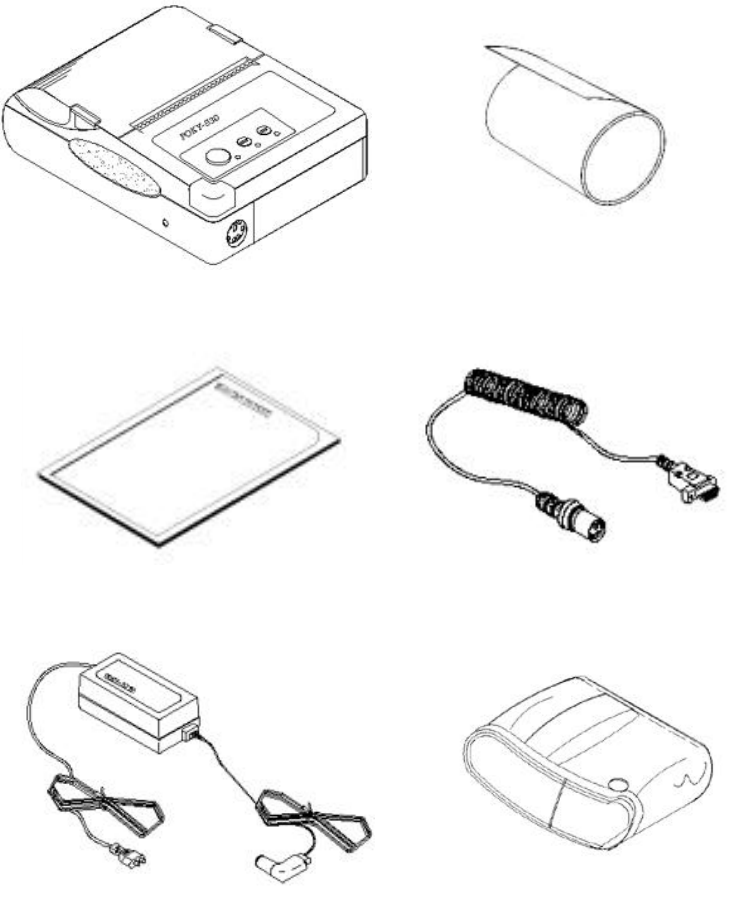
Chapter1.Setting up theprinter
1.1Unpacking
Yourprinterbox shouldinclude theseitems. If anyitemsare damaged or
missing,pleasecontactyourdealerforassistance.
PORTI-SRoll Paper
Operator'sManual Connector
Adaptorforbatteryrecharge Leatherettecase
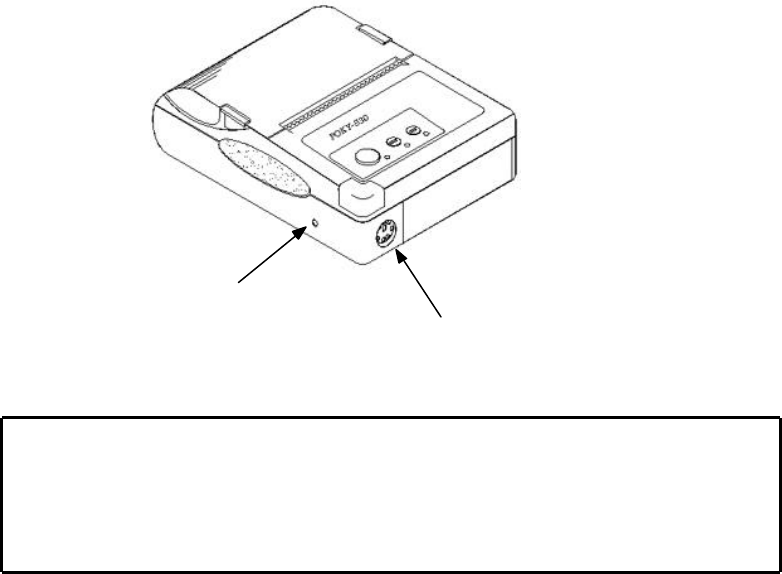
1.2.Connecting the cable
You can connectup totwocablestothe printer. It connectstothe connector
parton the left and frontside of the printer,whichis shown below.
Refertothe APPENDIX B formoreinformation aboutcommunication connector.
Note:Before connecting the cable,make surethatboththehost
and thepowerbutton toapplytotheprinterareturned off.
Ifyourpowersupplyisbroken oroutoforder,please
contactyourdealerforassistance.
Powerconnector
Commucation connectorforRS232C
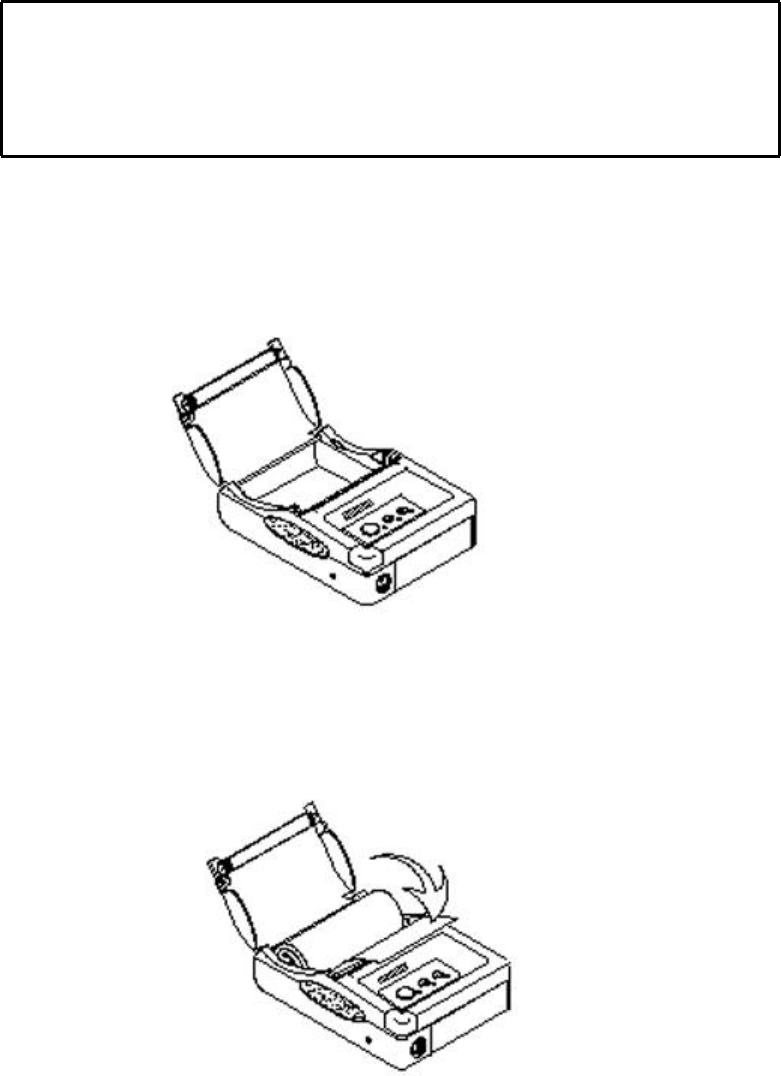
1.3. Installing or replacing thepaper roll
1.Makesurethat the printerisnotreceiving data;otherwise,datamaybe lost.
2.Open the paper roll coverbyapplying yourfingeron bothside ofprinter,
pushitup when the lock isreleased as showninthe drawing.
3.Removethe used paper roll coreif thereisone.
4. Insert the paper roll as shown.
Note:Be sureto use paper rollsthatmeet the specifications.
Do notuse paper rollsthathave thepapergluedtothe
corebecause theprintercannotdetect thepaperend
correctly.
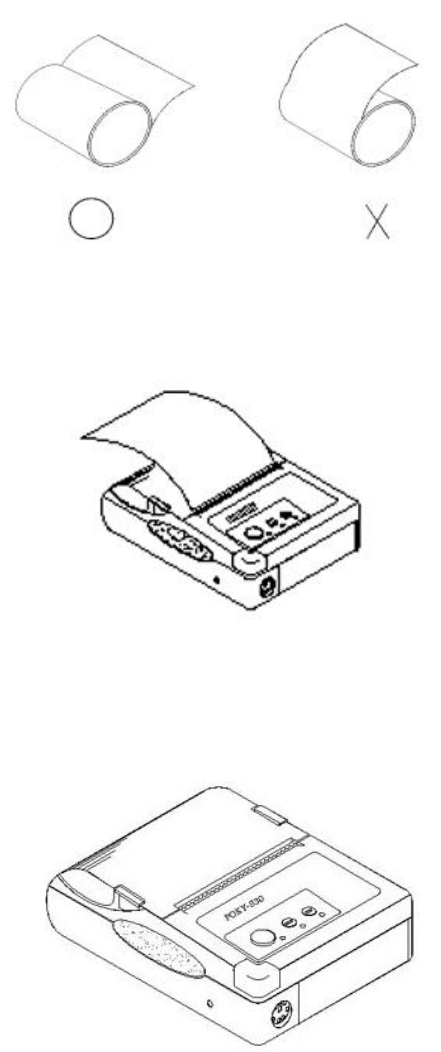
5.Besureto notethe correctdirection that the papercomesoff the roll.
6,Pull outasmall amountofpaperand then closethe cover,as shown.
7.Tearoff the paperas shown.
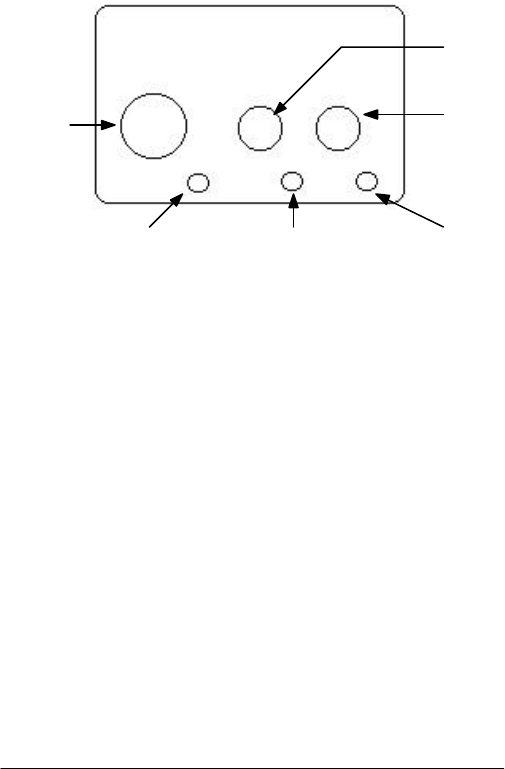
1.4.Adjustments and setting
The PORTI-Sis setup at the factoryto be appropriateforalmostall users.
Butifyou wantanotherspecification tofit the printeratyoursystemsuch as
change the baud rate,handshaking,parity check,aswell asprintdensity,please
contact to ourdevelopment teamoryourdealer.
1.5.Using theprinter
1.ControlPanel
2.Button
1)MODE
Mode button isforusetochange communication mode.
The communication mode is set toRAWIrDAmode when the powerison.
Press the mode button once, the mode will be changed toStandardIrDA
(Version 1.0)forWindows98,pleaseconfirmthe mode LED will twinkle
2times.
Press the mode button twice, the mode will be changed toRS-232Cmode
forWindows98,pleaseconfirmthe mode LED will twinkle3times.
All communication environmentmustbe setwith 9600 bps,1stop bit, no
parity,no flowcontrol.
If you want to usethe standardIrDAmode forWindows98,check the your
computer'sIrDAspeed.
Forexample,
Yourcomputer ->StartMenu ->Setting ->ControlPanel->IrDA->Option
->Communication Speed Limitation With57600 bps
POWER
MODE
FEED
POWERLEDMODELEDERRORLED
2)FEED
Press the FEEDbutton onceto advance paperone line.You can also hold
downthe FEEDbutton tofeed papercontinuously.
3.Panel lights
1)POWERLED
The POWERlightison wheneverthe printerison.
Butwhen the batteryisalmostexhausted, thisled flasheswithred color
occasionally.
Inthis case,you mustrecharge the batterybyusing the powersupply.
2)MODELED
Normallythisled isoff.
Butifyou select the protocolIrDAmode using the mode key,it flashesonce.
Incase ofselecting the RS232Cmode bypressing the mode key,it flashes
twicetimes.
3)ERRORLED
Thisled indicatesan errorsuch aspaperend,orcoveropen,etc
Chapter2.The self test
The self-testchecks whetherthe printerhasanyproblems. If the printerdoesnot
function properly,contactyourdealer.The self-testchecks the following;
1.Makesure paper roll hasbeen installed properly.
2.Turnonthe powerwhile holding downthe FEEDbutton.The self-testbegins.
3.The self-testprintsthe currentprinterstatus,which providesthe controlROM
version and the communication method setting.
4.Afterprinting the currentprinterstatus,self-testprinting will printa pattern using
the built-incharacterset.
5.The self-testautomaticallyends
The printerisreadytoreceive data as soon asitcompletesthe self-test.
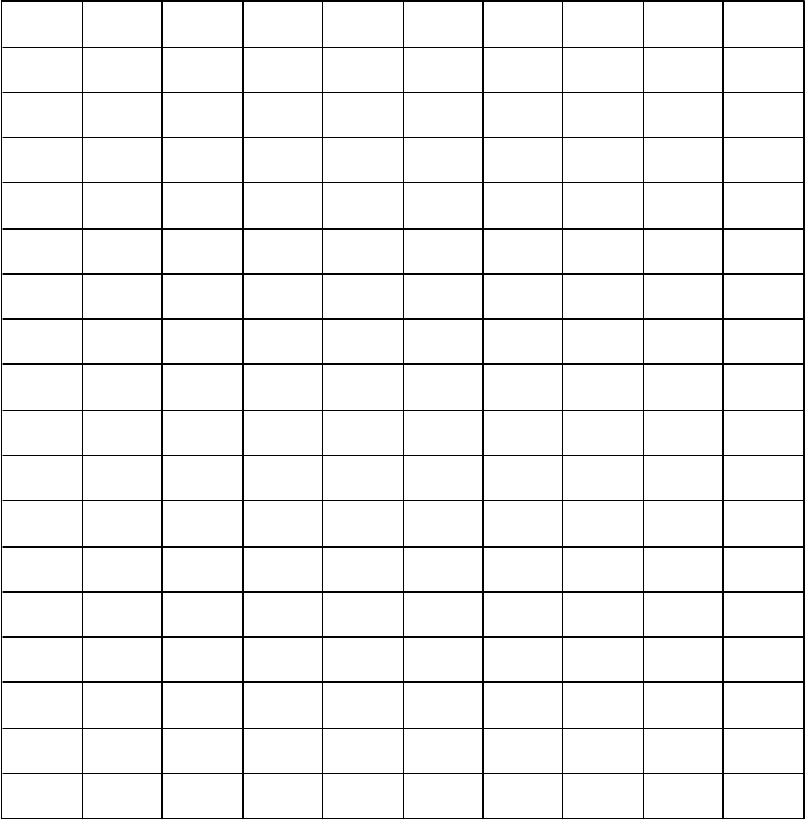
Chapter3.Codetable
The following pages showthe charactercode tables.Tofind the character
corresponding to a hexadecimalnumber,countacross the top of the tableforthe
left digitand countdownthe left column of the tableforthe rightdigit.
Forexample 4A=J
HEX 0 1 2 3 4 5 6 7
HEX BIN0000 0001 0010 0011 0100 0101 0110 0111
0 0000 NULL DLE SP 0@P`p
1 0001 !1AQa q
2 0010 "2BRbr
3 0011 # 3 CSc s
4 0100 EOT$ 4 DTdt
5 0101 ENQ%5EUe u
6 0110 &6FVfv
7 0111 '7GWgw
8 1000 CAN(8HXhx
9 1001 HT)9IYiy
A1010 LF*:JZjz
B1011 ESC+;K[k{
C1100 FF ,<L\l|
D1101 CR GS-=M]m}
E1110 .>N^n~
F1111 /?O_ o SP
Page 0 (PC437 ;USA,StandardEurope) (0x00 -0x7F)
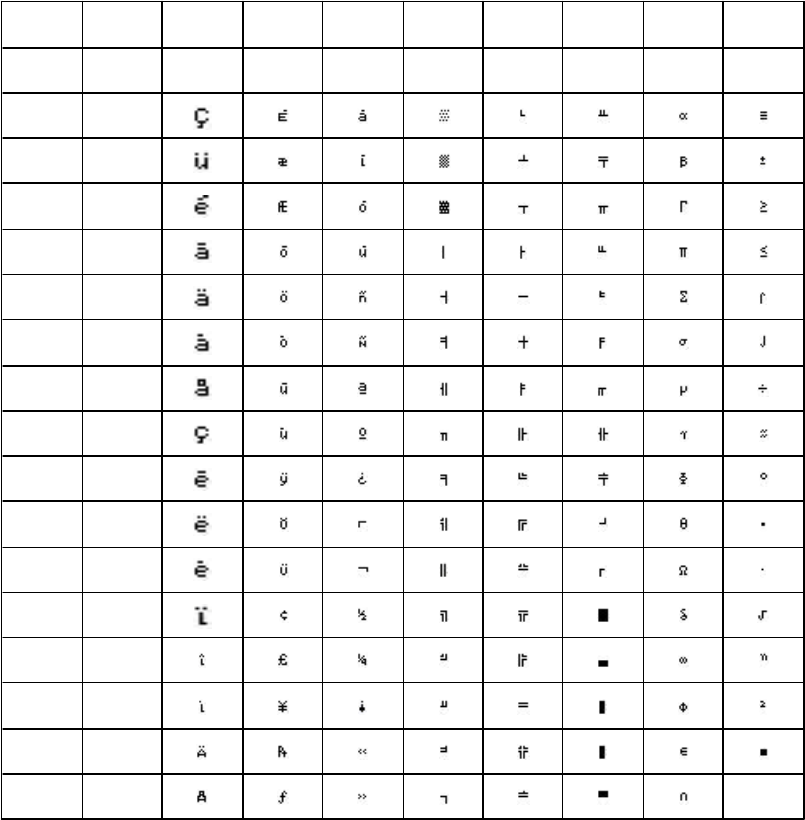
HEX 8 9 A B C D EF
HEX BIN1000 1001 1010 1011 1100 1101 1110 1111
0 0000
1 0001
2 0010
3 0011
4 0100
5 0101
6 0110
7 0111
8 1000
9 1001
A1010
B1011
C1100
D1101
E1110
F1111 SP
Page 0 (PC437 ;USA,StandardEurope) (0x80 -0xFF)

Chapter4.Controlcommands
Command Notation
[Name]The name of the command
[Format] The code sequence
ASCII indicatesthe ASCII equivalents
HEX indicatesthe hexadecimalequivalents.
Decimal indicatesthe decimalequivalents.
[ ]kindicatesthe contentsof the []shouldberepeated ktimes.
[Range]Givesthe allowablerangesforthe arguments.
[Description]Describesthe function of the command.
Explanation ofTerms
LSB LeastSignificantBit
MSB MostSignificantBit
ControlCommands
[Name]HorizontalTab
[Format] ASCII HT
HEX 09
Decimal9
[Description]Movesthe printposition tothe nexthorizontaltab position.
[Notes]
[Reference]ESC D
1)This command isignored unless the nexthorizontaltab position
hasbeen set.
2)If the nexthorizontaltab position exceedsthe printing area, the
printersetsthe printing position to[Printing area width+1]'
3)Horizontaltab positionsaresetwithESC D.
4)If this command isreceived when the printing position isat [
Printing area width+1], the printerexecutesprintbuffer-full
printing of the currentline and horizontaltab processing from
the beginning of the nextline.
5)The defaultsetting of the horizontaltab position forthe paper
roll isevery8thcharacter(9th,17th,25th, ... column).
HT
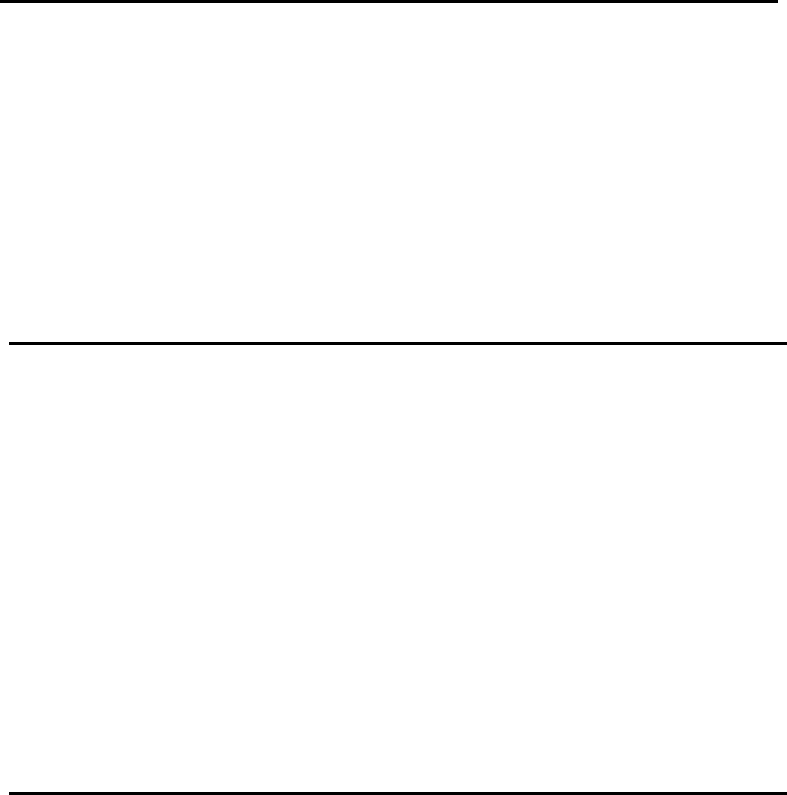
LF
[Name]Printand line feed
[Format] ASCII LF
HEX 0A
Decimal10
[Description]Printsthe datainthe printbufferand feedsone line based on the
currentline spacing.
[Notes]This command setsthe printposition tothe beginning of the line.
[Reference]ESC2,ESC3
FF
[Name]Printand returntostandardmode in page mode.
[Format] ASCII FF
HEX 0C
Decimal12
[Description]Printsthe datainthe printbuffercollectivelyand returnstostandard
mode.
[Notes]
[Reference]ESCFF,ESCL,ESCS
CAN
[Name]Cancelprintdatain page mode
[Format] ASCII CAN
HEX 18
Decimal24
[Description] In page mode,deletesall the printdatainthe currentprintable area.
[Notes]
[Reference]ESCL,ESCW
1)The bufferdataisdeleted afterbeing printed.
2)The Printing area setbyESCWisreset tothe defaultsetting.
3)This command setsthe printposition tothe beginning of the line.
4)This command isenabled onlyin page mode...
1)This command isenable onlyin page mode.
2)If datathatexisted inthe previously specified printing area also
existsinthe currently specified printing area,itisdeleted.
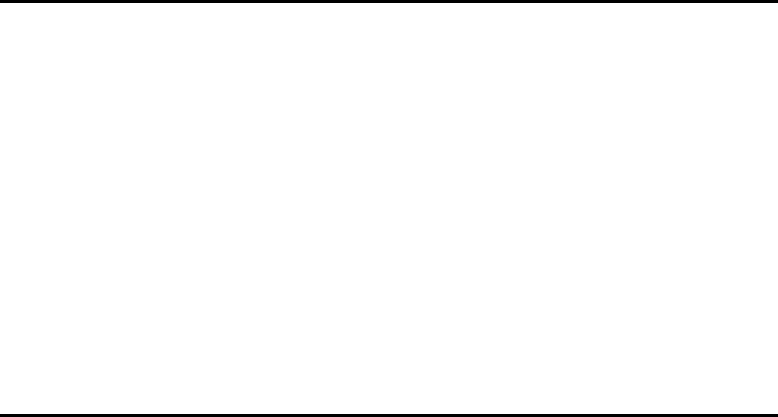
ESCFF
[Name]Printdatain page mode
[Format] ASCII ESCFF
HEX 1B0C
Decimal27 12
[Description] In page mode,printsall buffered datainthe printing area collectively.
[Notes]This command isenabled onlyin page mode.
Afterprinting, the printerdoesnotclearthe buffered data,setting
valuesforESCTand ESCW,and the position forbuffering
characterdata.
[Reference]FF,ESCL,ESCS
ESCSP n
[Name]Setrightside characterspacing.
[Format] ASCII ESCSP n
HEX 1B20 n
Decimal27 32 n
[Range]0<= n<= 255
[Description]Setsthe characterspacing forthe rightside of the characterto
[nxhorizontalorverticalmotion units].
[Notes]1)The rightside characterspacing fordouble-widthmode istwice
the normalvalue.When charactersare enlarged, the rightside
characterspacing isntimesnormalvalue.
2)This command sets valuesindependentlyin eachmode.
3)The horizontaland verticalmotion unitarespecified byGS P.
Changing the horizontalorverticalmotion unitdoesnotaffect the
currentright-side spacing.
4)The GS P command can change the horizontal(and vertical)
motion unit. However, the value cannotbe less than the minimum
horizontalmovementamount, and itmustbe in even unitsof the
minimumhorizontalmovementamount.
5)The maximumrightside spacing if255/180 inches,Any setting
exceeding the maximumis converted tothe maximum
automatically.
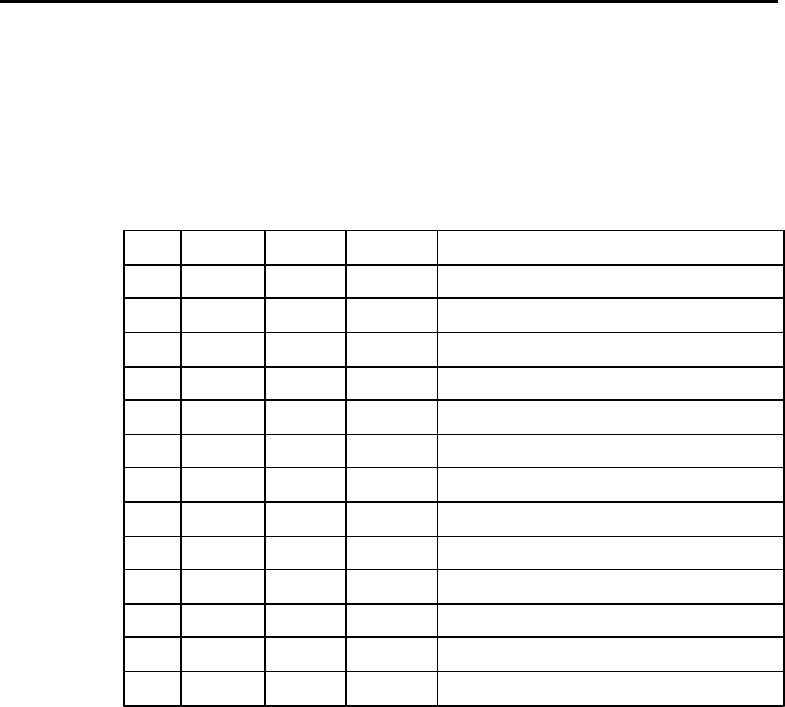
[Default] n=0
[Reference]GS P
ESC!n
[Name]Selectprintmode
[Format] ASCII ESC!n
HEX 1B21 n
Decimal27 33 n
[Range]0<= n<= 255
[Description]Selectsprintmode(s)using n asfollows.
[Notes]
BitOff/OnHex DecimalFunction
0Off 00 0 CharacterfontA(12x24)
On 01 1 CharacterfontB(9x17)
1- - - Undefined
2- - - Undefined
3Off 00 0 Emphasized mode notselected
On 08 8 Emphasized mode selected
4Off 00 0 Double-heightmode notselected
On 10 16 Double-heightmode selected
5Off 00 0 Double-widthmode notselected
On 20 32 Double-widthmode selected
6- - - Undefined
7Off 00 0 Underline mode notselected
On 80 128 Underline mode selected
1)When both double-heightand double-widthmodesareselected,
quadruplesizecharactersare printed.
2)The printercan underline all characters,butcan notunderline the
spacesetbyHT.
3)The thickness of the underline isthatselected byESC-,regardless
of the charactersize.

[Reference]ESC-,ESCE,GS!
ESC$nL nH
[Name]Setabsolute printposition.
[Format] ASCII ESC$ nL nH
HEX 1B24 nL nH
Decimal27 36 nL nH
[Range]0<= nL <= 255
0<= nH<= 255
[Description]Set the distancefromthe beginning of the line tothe position at
whichsubsequentcharactersareto be printed.
[Notes]
4)When somecharactersinaline are double ormore height, all the
characterson the line are aligned at the baseline.
5)ESCEcan alsoturn on oroff emphasized mode.However, the
setting of the lastreceived command iseffective.
6)ESC-can alsoturn on oroff underline mode.However, the setting
of the lastreceived command iseffective.
7)GS!can alsoselectcharactersize.However, the setting of the last
received command iseffective..
1)The distancefromthe beginning of the line tothe printposition is
[(nL +nHx256)x(verticalorhorizontalmotion unit)]inches.
2)Setting outside the specified printable area areignored.
3)The horizontaland verticalmotion unitarespecified byGS P.
4)The GS P command can change the horizontal(and vertical)
motion unit.
However, the value cannotbe less than the minimumhorizontal
movementamount, and itmustbe in even unitsofhe minimum
horizontalmovementamount.
5)Instandardmode, the horizontalmotion unit(x)isused.
6)In page mode,horizontalorverticalmotion unitdiffersdepending
on the starting position of the printable area asfollows;
1.When the starting position is set tothe upperleft orlower right
of the printable area using ESCT, the horizontalmotion unit(x)
isused.
2.When the starting position is set tothe upper rightorlowerleft
of the printable area using ESCT, the verticalmotion unit(y)isused.
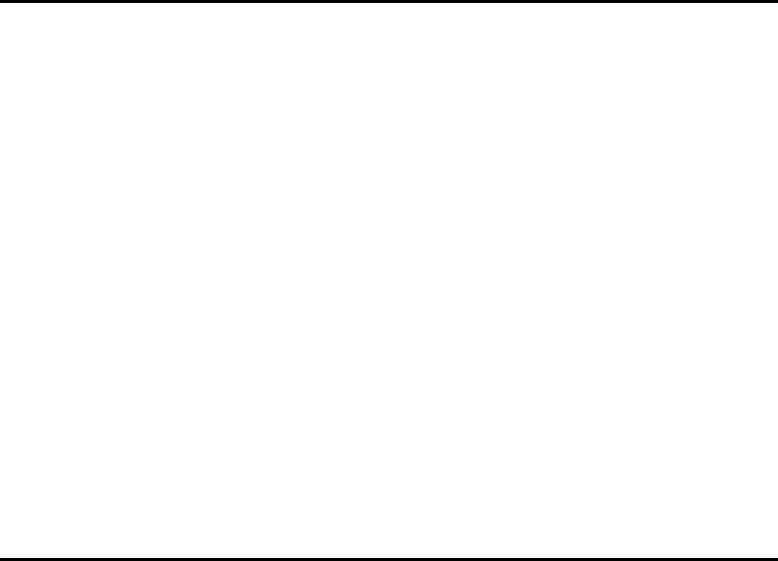
[Reference]ESC\, GS$,GS\, GS P
ESC%n
[Name]Select/Canceluserdefined characterset.
[Format] ASCII ESC%n
HEX 1B25 n
Decimal27 37 n
[Range]0<= n<= 255
[Description]Selectsorcancelsthe userdefined characterset.
[Notes]
[Default] n=0
[Reference]ESC$,ESC?
ESC&y c1 c2 [x1 d1...d(y x x1)]...[xk d1...d(y x xk)]
[Name]Define userdefined characters.
[Format] ASCII ESC&y c1c2[x1 d1...d[yxx1)]...[xk d1...d(y x xk)]
HEX 1B26 y c1c2[x1 d1...d[y x x1)]...[xk d1...d(y x xk)]
Decimal27 38 y c1c2[x1 d1...d[yxx1)]...[xk d1...d(y x xk)]
[Range]32 <= c1<= c2<= 126
0<= x<= 12 FontA(12 x24)
0<= x<= 9FontB(9x24)
0<= d1...d(y x xk)<= 255
[Description]Definesuserdefined characters.
[Notes]
1)When the LSB ofnis0, the userdefined charactersetis canceled.
2)When the LSB ofnis1, the userdefined charactersetis selected.
3)When the userdefined charactersetis canceled, the internal
charactersetisautomatically selected.
4)nisavailable onlyforthe leastsignificantbit.
1)y specifiesthe numberofbytesinthe verticaldirection.
2)c1specifiesthe beginning charactercode forthe definition,and c2
specifiesthe finalcode.
3)x specifiesthe numberofdotsinthe horizontaldirection.
4)The allowablecharactercode range isfromASCII code <20H>to
<7EH>(95 characters)
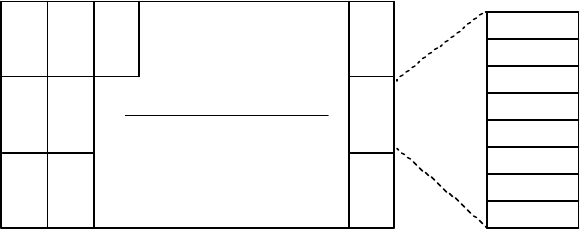
[Default] The internalcharacterset
[Reference]ESC%,ESC?
[Example]
-When fontA(12x24)is selected.
5)It ispossibleto define multiplecharactersforconsecutivecharacter
codes.
If onlyone characterisdesired,usec1=c2.
6)disthe dotdataforthe characters.The dotpatternisinthe
horizontaldirection fromthe left side.Anyremaining dotson the right
side are blank.
7)The datato define a userdefined characteris(y x x)bytes.
8)Setacorresponding bit to1to printa dotorto 0 not to printa dot.
9)This command can define differentuser-defined characterpatternsby
eachfonts.Toselectafont, useESC!
10)Auser-defined characterand a downloaded bitimage cannotbe
defined simultaneously.When this command isexecuted, the
downloaded bitimage is cleared.
11)The user-defined characterdefinition is cleared when:
ESC@isexecuted.
ESC?isexecuted.
GS*isexecuted.
The printerisresetorthe poweristurned off.
12)When the user-defined charactersare defined infontB(9x17),only
the mostsignificantbitof the 3rd byte ofdatainverticaldirection is
effective.
d1 d4 d7 ........................... d34
d2 d4 d35
d3 d6 .................................... d36
MSB
LSB
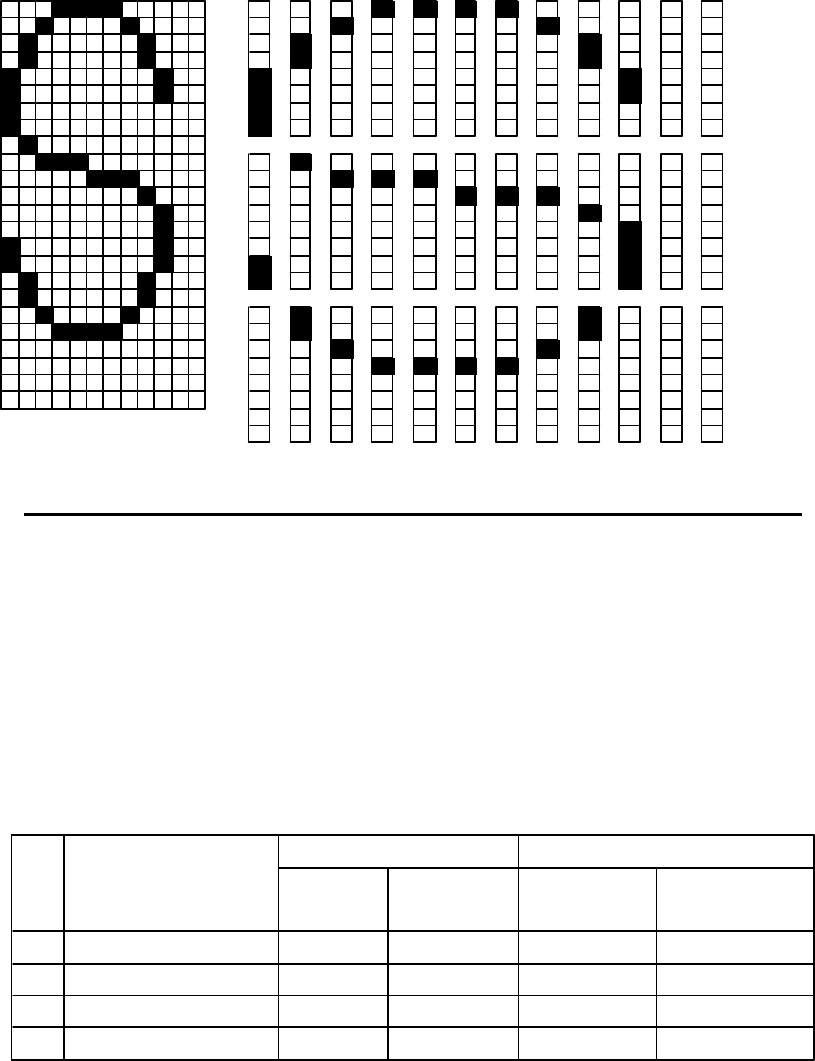
ESC*mnL nHd1...dk
[Name]Selectbit-image mode.
[Format] ASCII ESC&mnL nHd1...dk
HEX 1B2AmnL nHd1...dk
Decimal27 42 mnL nHd1...dk
[Range]m=0,1,32,33
0<= nL <= 255
0<= nH<= 3
0<= d<= 255
[Description]Selectsa bit-image mode using mforthe numberofdots specified
bynL and nH,asfollows:
[Notes]
=>
d1=<0F>H
d2=<03>H
d3=<00>H
d4=<30>H
d5=<80>H
d6=<00H>
d7=<40H>
d8=<40H>
d9=<20>H
.
.
.
mMode
Verticaldirection Horizontaldirection
Number
ofDotsDotdensityDotdensityNumberof
Data
0 8-dotsingle density8 60 DPI90 DPInL+nHx256
1 8-dotdouble density8 60 DPI180 DPInL+nHx256
32 24-dotsingle density24 180 DPI90 DPI(nL+nHx256)x3
33 24-dotdouble density24 180 DPI180 DPI(nL+nHx256)x3
1)If the valuesofmisoutof the specified range,nL and datafollowing
are processed an normaldata.
2)The nL and nHindicatethe numberofdotsof the bitimage inthe
horizontaldirection.
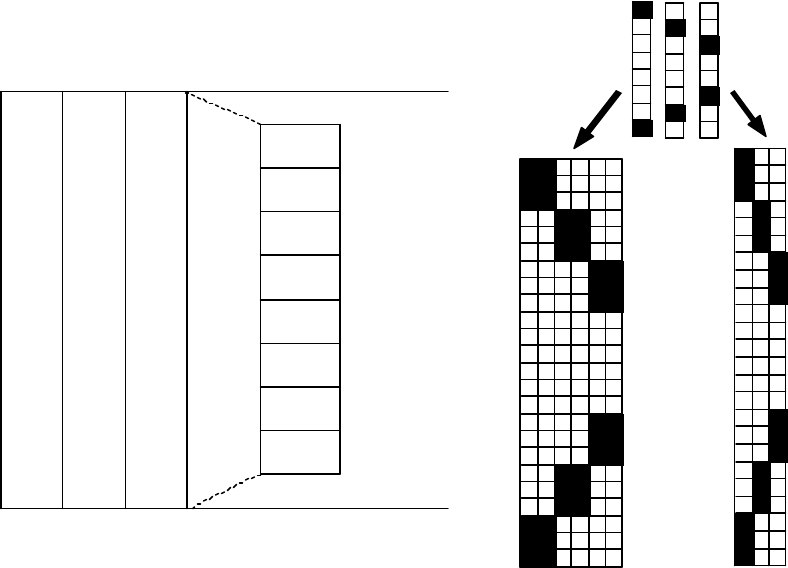
-When 8-dotbitimage is selected:
3)The numberofdotsis calculated bynL +nHx256.
4)If the bit-image datainputexceedsthe numberofdotsto be printed
on a line, the excess dataisignored.
5)dindicatesthe bit-image data.Setacorresponding bit to1to printa
dotorto 0 to notprinta dot.
6)If the width of the printing area setbyGSL and GSWless than
the widthrequired bythe datasentwiththe ESC*command, the
following will be performed on the line in question (but the printing
cannotexceed the maximumprintable area):
The width of the printing area isextended tothe right to
accommodatethe amountofdata.
If step doesnotprovide sufficientwidthforthe data, the left margin
isreduced to accommodatethe data.
7)Afterprinting a bitimage, the printer returnsto normaldata
processing mode.
8)This command isnotaffected byprintmodes(emphasized,double-
strike,underline,charactersize orwhite/black reverse printing),except
upside-down printing mode.
9)The relationship between the image data and the dotsto be printed
isasfollows;
d1 d2 d3
MSB
LSB
Bit-image data
Printdata
Bit-image data
d1 d2 d3
Printdata
1dot
Single densityDouble density
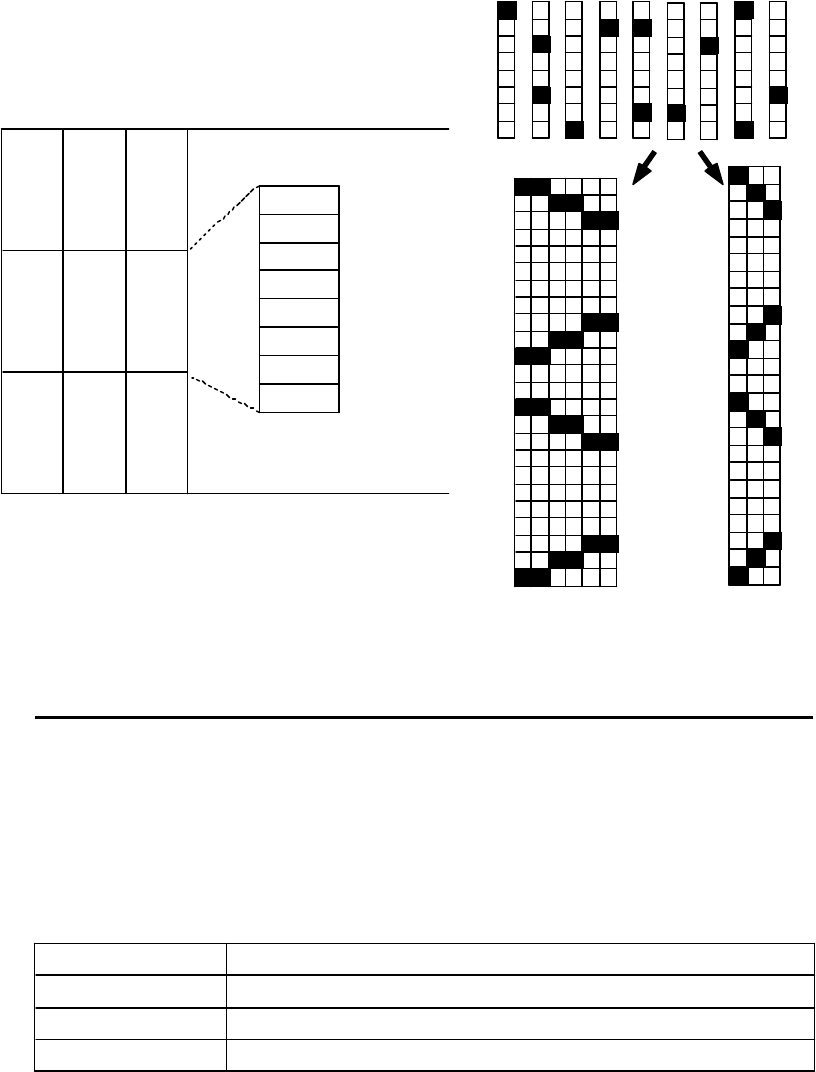
-When 24-dotbitimage is selected:
ESC-n
[Name]Turn underline mode on/off
[Format] ASCII ESC-n
HEX 1B2Dn
Decimal27 45 n
[Range]0<= n<= 2,48 <= n<= 50
[Description]Turnsunderline mode on oroff, based on the following valuesofn;
d1 d4 d7
d2 d5 d8
d3 d6 d9
MSB
LSB
Bit-image data
Printdata
Bit-image data
d1 d2 d3
Printdata
1dot
Single densityDouble density
d4 d5 d6 d7 d8 d9
n Function
0,48 Turnsoff underline mode.
1,49 Turnson underline mode (1-dot thick).
2,50 Turnson underline mode (2-dot thick).
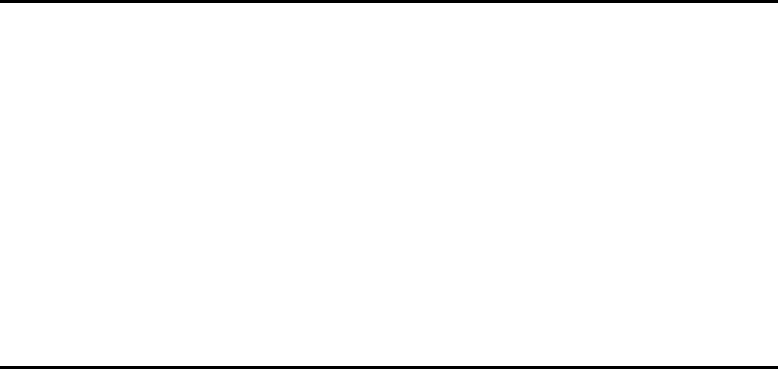
[Notes]
[Default] n=0
[Reference]ESC!
ESC2
[Name]Selectdefaultline spacing
[Format] ASCII ESC2
HEX 1B32
Decimal27 50
[Description]Selects1/6inchline (approximately4.23mm)spacing.
[Notes]The line spacing can be setindependentlyinstandardmode and
in page mode.
[Reference]ESC3
ESC3n
[Name]Setline spacing
[Format] ASCII ESC3 n
HEX 1B33 n
Decimal27 51 n
[Range]0<= n<= 255
[Description]Setsthe line spacing to[nx verticalorhorizontalmotion unit]inches
[Notes]1)The line spacing can be setindependentlyinstandardmode and
in page mode.
1)The printercan underline all characters(including right-side character
spacing),butcannotunderline the spacesetbyHT.
2)The printercannotunderline white/black inverted characters.
3)When underline mode idturned off by setting the value ofnto0or
48, the following dataisnotunderlined,and the underline thickness
setbeforethe mode isturned off doesnotchange.The default
underline thickness is1 dot.
4)Changing the charactersize doesnotaffect the currentunderline
thickness.
5)Underline mode can alsobeturned on oroff byusing ESC!. Note,
however, that the lastreceived command iseffective.

2)The horizontaland verticalmotion unitarespecified byGS P.
Changing the horizontalorverticalmotion unitdoesnotaffect the
currentline spacing.
3)The GS P command can change the horizontal(and vertical)
motion unit. However, the value cannotbe less than the minimum
verticalmovementamount, and itmustbe in even unitsof the
minimumverticalmovementamount.
4)Instandardmode, the verticalmotion unit(y)isused.
5)In page mode, this command functionsasfollows,depending on
the starting position of the printable area:
When the starting position is set tothe upperleft orlower rightof
the printable area using ESCT, the verticalmotion unit(y)isused
When the starting position is set tothe upper rightorlowerleft of
the printable area using ESCT, the horizontalmotion unit(x)is
used.
6)The maximumpaperfeed amountis1016 mm (40 inches).Even
ifa paperfeed amountofmorethan 1016 mm (40 inches)is set,
the printerfeedsthe paperonly1016 mm (40 inches).
[Default] Line spacing equivalent to approximately4.23mm (1/6inches).
[Reference]ESC2,GS P
ESC? n
[Name]Canceluserdefined characters.
[Format] ASCII ESC? n
HEX 1B3Fn
Decimal27 63 n
[Range]32 <= n<= 126
[Description]Cancelsuserdefined characters.
[Notes]1)This command cancelsthe pattern defined forthe charactercode
specified byn.Afterthe userdefined charactersis canceled, the
corresponding patternforthe internalcharacterisprinted.
2)This command deletesthe pattern defined forthe specified code
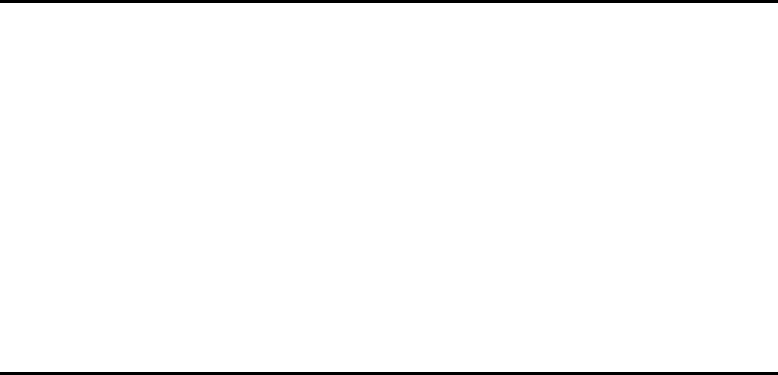
inthe fontselected byESC!.
3)If a userdefined characterhasnotbeen defined forthe specified
charactercode, the printerignoresthis command.
[Reference]ESC &,ESC%
ESC@
[Name] Initialize printer.
[Format] ASCII ESC@
HEX 1B40
Decimal27 64
[Description]Clearsthe datainthe printbufferand resetsthe printermode tothe
mode thatwasin effectwhen the powerwasturned on.
[Notes]1)The datainthe receive bufferisnotcleared.
2)The macro definition isnotcleared.
ESCDn1...nkNUL
[Name]Sethorizontaltab positions.
[Format] ASCII ESC D n1...nkNUL
HEX 1B44 n1....nk00
Decimal27 68 n1....nk0
[Range]1<= n<= 255
0<= k<= 32
[Description]Setshorizontaltab position.
[Notes]1)nspecifiesthe column numberforsetting a horizontaltab position
fromthe beginning of the line.
2)kindicatesthe totalnumberofhorizontaltab positionstobeset.
3)The horizontaltab position is stored asavalue of [characterwidth
xn]measured fromthe beginning of the line.The characterwidth
includesthe right-side characterspacing,and double-width
charactersaresetwithtwicethe width ofnormalcharacters.
4)This command cancelsthe previoushorizontaltab settings.
5)When setting n=8, the printposition ismoved tocolumn9by

sending HT.
6)Upto32tab positions(k=32)can be set. Data exceeding 32 tab
positionsisprocessed asnormaldata.
7)Transmit [n]kin ascending orderand placeaNULcode 0 at the
end.
8)When [n]kisless than orequaltothe preceding value [n]k-1, tab
setting isfinished and the following dataisprocessed asnormal
data.
9)ESC D NULcancelsall horizontaltab positions.
10)The previously specified horizontaltab positionsdo notchange,
even if the characterwidthchanges.
11)The characterwidthismemorized foreachstandard and page
mode.
[Default] The default tab positionsare atintervalsof8characters(columns9,
17,25, ...)forfontA(12x24)
[Reference]HT
ESCEn
[Name]Turn emphasized mode on/off.
[Format] ASCII ESCEn
HEX 1B45 n
Decimal27 69 n
[Range]0<= n<= 255
[Description]Turnsemphasized mode on oroff
When the LSB is0,emphasized mode isturned off.
When the LSB is1,emphasized mode isturned on.
[Notes]1)Onlythe leastsignificantbitofnisenabled.
2)This command and ESC! turn on and off emphasized mode in
the sameway.
Becarefulwhen this command isused withESC!
[Default] n=0
[Reference]ESC!

ESCJn
[Name]Printand feed paper.
[Format] ASCII ESCJn
HEX 1B4An
Decimal27 74 n
[Range]0<= n<= 255
[Description]Printsthe datainthe printbufferand feedsthe paper[nx verticalor
horizontalmotion unit] inches.
[Notes]1)Afterprinting is completed, this command setsthe printstarting
position tothe beginning of the line.
2)The paperfeed amountsetbythis command doesnotaffect the
values setbyESC2 orESC3.
3)The horizontaland verticalmotion unitarespecified byGS P.
4)The GS P command can change the vertical(and horizontal)
motion unit.
However, the value cannotbe less than the minimumvertical
movementamount, and itmustbe in even unitsof the minimum
verticalmovementamount.
5)Instandardmode, the printerusesthe verticalmotion unit(y).
6)In page mode, this command functionsasfollows,depending on
the starting position of the printable area;
When the starting position is set tothe upperleft orlower rightof
the printable area using ESCT, the verticalmotion unit(y)isused
When the starting position is set tothe upper rightorlowerleft of
the printable area using ESCT, the horizontalmotion unit(x)is
used.
7)The maximumline spacing is1016mm (40inches).When the
setting value exceedsthe maximum,itis converted tothe
maximumautomatically.
[Reference]GS P
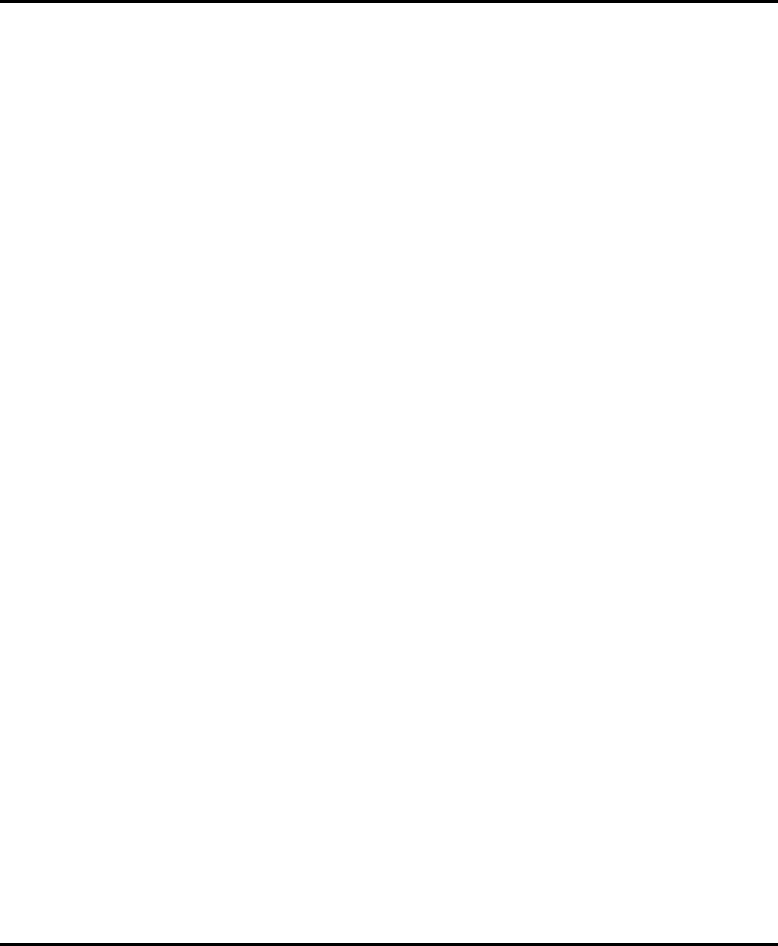
ESCL
[Name]Selectpage mode
[Format] ASCII ESCL
HEX 1B4C
Decimal27 76
[Description]Switchesfromstandardmode to page mode.
[Notes]1)This command isenabled onlywhen processed at the beginning
ofaline instandardmode.
2)This command hasno effectin page mode.
3)Afterprinting byFF is completed orbyusing ESCS, the printer
returnstostandardmode.
4)This command setsthe position where dataisbuffered tothe
position specified byESCTwithinthe printing area defined by
ESCW.
5)This command switchesthe settingsforthe following commands
(inwhichthe values can be setindependentlyinstandardmode
and page mode)tothoseforpage mode;
Setright-side characterspacing :ESCSP
Selectdefaultline spacing :ESC2,ESC3
6)Only valvesettingsispossibleforthe following commandsin page
mode; thesecommandsare notexecuted.
Selectjustification :ESCa
Turn upside-down printing mode on/off:ESC{
Setleft margin:GSL
Setprintable area width:GSW
7)The printer returnstostandardmode when poweristurned on,
the printerisreset, orESC@isused.
[Reference]FF,CAN,ESCFF,ESCS,ESCT,ESCW,GS$,GS\
ESCRn
[Name]Selectan internationalcharacterset.
[Format] ASCII ESC R n
HEX 1B52 n
Decimal27 82 n
[Range]0<= n<= 10
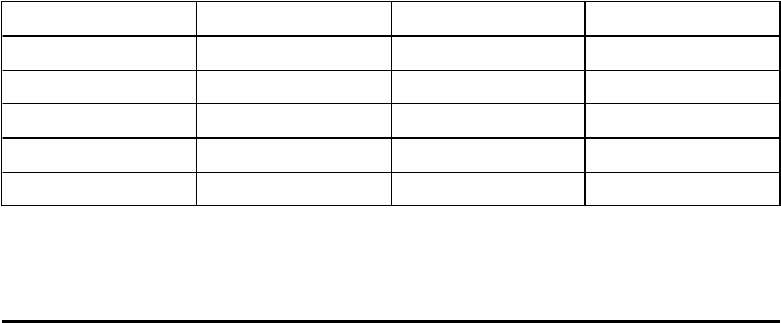
[Description]Selectsan internationalcharactersetnfromthe following table.
[Default] n=0
ESCS
[Name]Selectstandardmode
[Format] ASCII ESCS
HEX 1B53
Decimal27 83
[Description]Switchesfrompage mode tostandardmode.
[Notes]1)This command iseffective onlyin page mode.
2)Data buffered in page mode arecleared.
3)This command setsthe printposition tothe beginning of the line.
4)The printing area setbyESCWareinitialized.
5)This command switchesthe settingsforthe following commands
(inwhichthe values can be setindependentlyinstandardmode
and page mode)tothoseforstandardmode;
Setright-side characterspacing :ESCSP
Selectdefaultline spacing :ESC2,ESC3
6)The following commandsare enabled onlytosetinstandardmode.
Setprinting area in page mode :ESCW
Selectprintdirection in page mode :ESCT
7)The following commandsareignored instandardmode.
Setabsoluteverticalprintposition in page mode :GS$
Setrelativeverticalprintposition in page mode :GS\
8)Standardmode is selected automaticallywhen poweristurned on,
the printerisreset, orcommand ESC@isused.
nCharactersetnCharacterset
0U.S.A.6Sweden
1France 7 Italy
2Germany8Spain
3U.K.9Norway
4DenmarkI10 DenmarkII
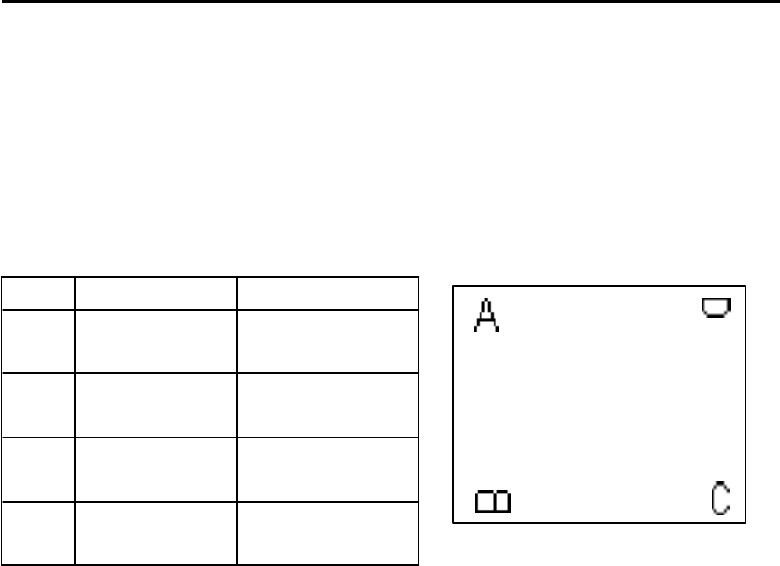
[Reference]FF,ESCFF,ESCL
ESCT n
[Name]Selectprintdirection in page mode
[Format] ASCII ESCTn
HEX 1B54 n
Decimal27 84 n
[Range]0<= n<= 3 or48 <= n<= 51
[Description]Selectsthe printdirection and starting position in page mode.
nspecifiesthe printdirection and starting position asfollows;
[Notes]1)When the command isinputinstandardmode, the printer
executesonlyinternalflag operation.This command doesnot
affectprinting instandardmode.
2)This command setsthe position where dataisbuffered withinthe
printing area setbyESCW.
3)Parametersforhorizontalorverticalmotion units(XorY)differas
follows,depending on the starting position of the printing area;
If the starting position isthe upperleft orlower rightof the
printing area,dataisbuffered inthe direction perpendiculartothe
paperfeed direction.
Commandsusing horizontalmotion unit: ESCSP,ESC$,ESC\
Commandsusing verticalmotion unit: ESC3,ESCJ,GS$,GS\
If the starting position isthe upper rightorlowerleft of the
printing area,dataisbuffered inthe paperfeed direction.
nPrintdirection Starting position
0,48 Left torightUpperleft
(Ainthe figure)
1,49 Bottomtotop Lowerleft
(Binthe figure)
2,50 Right toleft Lower right
(Cinthe figure)
3,51 Top to bottomUpper right
(Dinthe figure)
Printarea

Commandsusing horizontalmotion units:ESC3,ESCJ,GS$,GS\
Commandsusing verticalmotion units:ESCSP,ESC$,ESC\
[Default] n=0
[Reference]ESC$,ESCL,ESCW,ESC\, GS$,GS P,GS\
ESCWxLxHyLyHdxL dxHdyL dyH
[Name]Setprinting area in page mode
[Format] ASCII ESCWxLxHyLyHdxL dxHdyL dyH
HEX 1B57 xLxHyLyHdxL dxHdyL dyH
Decimal27 87 xLxHyLyHdxL dxHdyL dyH
[Range]0<= xL,xH,yL,yH,dxL,dxH,dyL,dyH<= 255
(exceptdxL=dxH=0 ordyL=dyH=0)
[Description]The horizontalstarting position,verticalstarting position,printing area
width,and printing area heightare defined as x0,y0,dx(inch),
respectively.
x0=[(xL+xHx256)]x(horizontalmotion unit)
y0=[(yL+yHx256)]x(verticalmotion unit)
dx=[(dxL+dxHx256)]x(horizontalmotion unit)
dy=[(dyL+dyHx256)]x(verticalmotion unit)
The printing area is setas showninthe figure below.
[Notes]1)If this commandsisinputinstandardmode, the printerexecutes
onlyinternalflag operation.This command doesnotaffectprinting
instandardmode.
2)If the horizontalorverticalstarting position is setoutside the
printable area, the printerstops command processing and
processesthe following data asnormaldata.
3)If the printing area width orheightis set to 0, the printerstops
command processing and processesthe following data asnormal
data.
4)This command setsthe position where dataisbuffered tothe
position specified byESCTwithinthe printing area.
5)If (horizontalstarting position +printing area width)exceedsthe
printable area, the printing area widthisautomatically set to
(horizontalprintable area-horizontalstarting position).
6)If (verticalstarting position +printing area height)exceedsthe
printable area, the printing area heightisautomatically set to
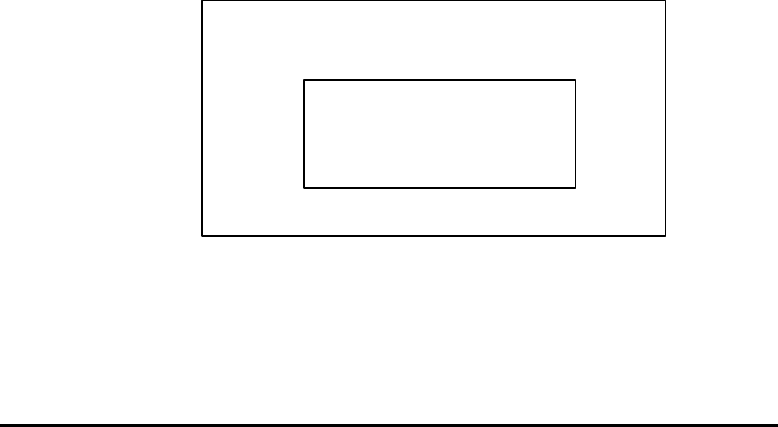
(verticalprintable area-verticalstarting position).
7)The horizontaland verticalmotion unitarespecified byGS P.
Changing the horizontalorverticalmotion unitdoesnotaffect the
currentprinting area.
8)The GS P command can change the horizontal(and vertical)
motion unit. However, the value cannotbe less than the minimum
horizontalmovementamount, and itmustbe in even unitsof
minimumhorizontalmovementamount.
9)Usethe horizontalmotion unit(x)forsetting the horizontalstarting
position and printing area width,and usethe verticalmotion unit
(y)forsetting the verticalstarting position and printing area height.
10)When the horizontalstarting position,verticalstarting position,
printing area width,and printing area heightare defined asX,Y,
Dx,Dyrespectively, the printing area is setas showninthe figure
below.
[Default] xL=xH=yL=yH=0
dxL=0,dxH=2,dyL=126,dyH=6
[Reference]CAN,ESCL,ESCT,GS P
ESC\nL nH
[Name]Setrelative printposition
[Format] ASCII ESC\nL nH
HEX 1B5CnL nH
Decimal27 92 nL nH
[Range]0<= nL <= 255,0<= nH<= 255
[Description]Set the printstarting position based on the currentposition byusing
the horizontalorverticalmotion unit.
[Notes]1)This command setsthe distancefromthe currentposition to
(X,Y)Paper
Dx
Dy
(X+Dx-1,Y+Dy-1)
Printarea
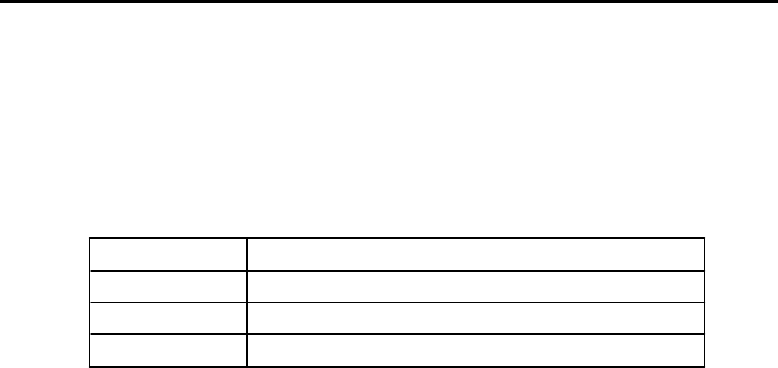
[(nL+nHx256)xhorizontalorverticalmotion unit]
2)Any setting thatexceedsthe printable areisignored
3)When pitchNis specified tothe right;
nL +nHx256 =N
When pitchNis specified tothe left (the negative direction),use
the complementof65536.
4)The printstarting position movesfromthe currentposition to[Nx
horizontalorverticalmotion unit)]
5)The horizontaland verticalmotion unitarespecified byGS P.
6)The GS P command can change the horizontal(and vertical)
motion unit.
However, the value cannotbe less than the minimumhorizontal
movementamount, and itmustbe in even unitsof the minimum
horizontalmovementamount.
7)Instandardmode, the horizontalmotion unitisused.
8)In page mode, the horizontalorverticalunitdiffersasfollows,
depending on the starting pointof the printing area;
When the starting position is set tothe upperleft orlower rightof
the printable area using ESCT, the horizontalmotion unit(x)is
used.When the starting position is set tothe upper rightorlower
left of the printable area using ESCT, the verticalmotion unit(y)
isused.
[Reference]ESC$,ESCP
ESCan
[Name]Selectjustification
[Format] ASCII ESCa n
HEX 1B61 n
Decimal27 97 n
[Range]0<= n<= 2,48 <= n<= 50
[Description]Alignsall the datain one line tothe specified position.
nselectsthe type ofjustification asfollows;
nJustification
0,48 Left justification
1,49 Centerjustification
2,50 Rightjustification

[Notes]1)The command isenabled onlywhen processed at the beginning
of the line instandardmode.
2)If this command isinputin page mode, the printerperformsonly
internalflag operations.
3)This command hasno effectin page mode.
4)This command executesjustification inthe printing area.
5)This command justifiesthe space area according toHT,ESC$ or
ESC\
[Default] n=0
[Example]
Left justification Centerjustification Rightjustification
ESCc 5 n
[Name]Enable/Disable panelbuttons
[Format] ASCII ESCc5 n
HEX 1B63 35 n
Decimal27 99 53 n
[Range]0<= n<= 255
[Description]Enablesordisablesthe panelbuttons.
When the LSB is0, the panelbuttonsare enabled.
When the LSB is1, the panelbuttonsare disabled.
[Notes]1)Onlythe leastsignificantbitofnis valid.
2)When the panelbuttonsare disabled,none of themare usable
when the printercoveris closed.
3)Inthisprinter, the panelbuttonsisthe FEEDbutton.
4)Inthe macroreadymode, the FEEDbutton are enabled
regardless of the settingsof this command;however, the paper
cannotbe fed byusing these buttons.
[Default] n=0
ABC
ABCD
ABCDE
ABC
ABCD
ABCDE
ABC
ABCD
ABCDE
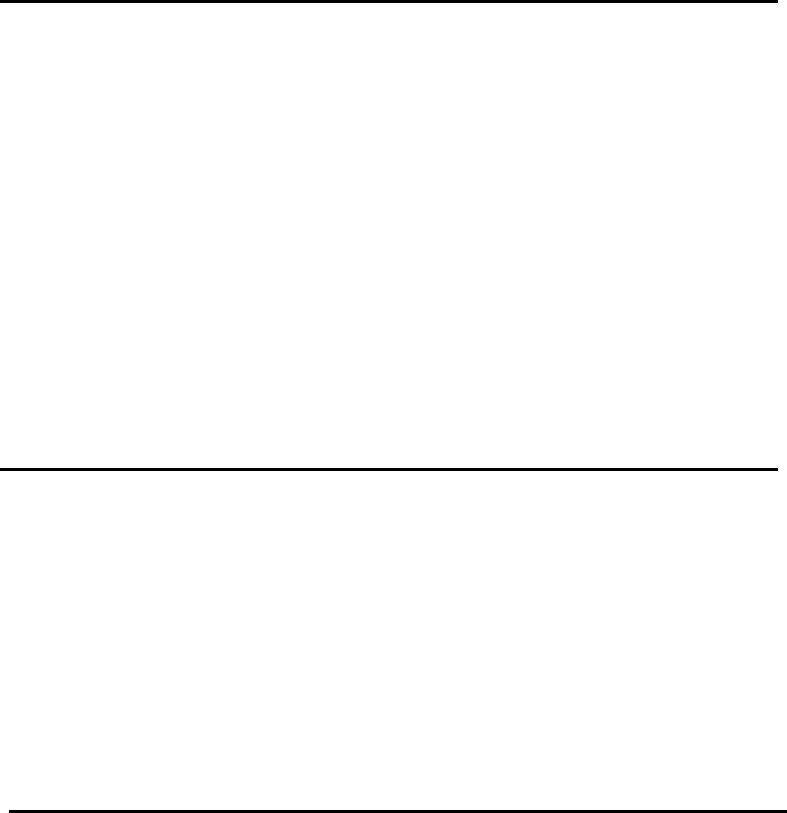
ESCd n
[Name]Printand feed n lines
[Format] ASCII ESCd n
HEX 1B64 n
Decimal27 100 n
[Range]0<= n<= 255
[Description]Printsthe datainthe printbufferand feedsnlines.
[Notes]1)This command setsthe printstarting position tothe beginning of
the line.
2)This command doesnotaffect the line spacing setbyESC2 or
ESC3.
[Reference]ESC2,ESC3
ESCy
[Name]Printand feed paperto nextlabel indexhole
[Format] ASCII ESCy
HEX 1B79
Decimal27 121
[Description]Printsthe datainthe printbuffercollectivelyand feed paperuntil
find nextindexhole oflabelpaper
ESC{n
[Name]Turn on/off upside-down printing mode.
[Format] ASCII ESC{n
HEX 1B7Bn
Decimal27 123 n
[Range]0<= n<= 255
[Description]Turnsupside-down printing mode on oroff
When the LSB is0,upside-downmode isturned off.
When the LSB is1,upside-downmode isturned on.
[Notes]1)Onlythe lowestsignificantbitofnis valid.
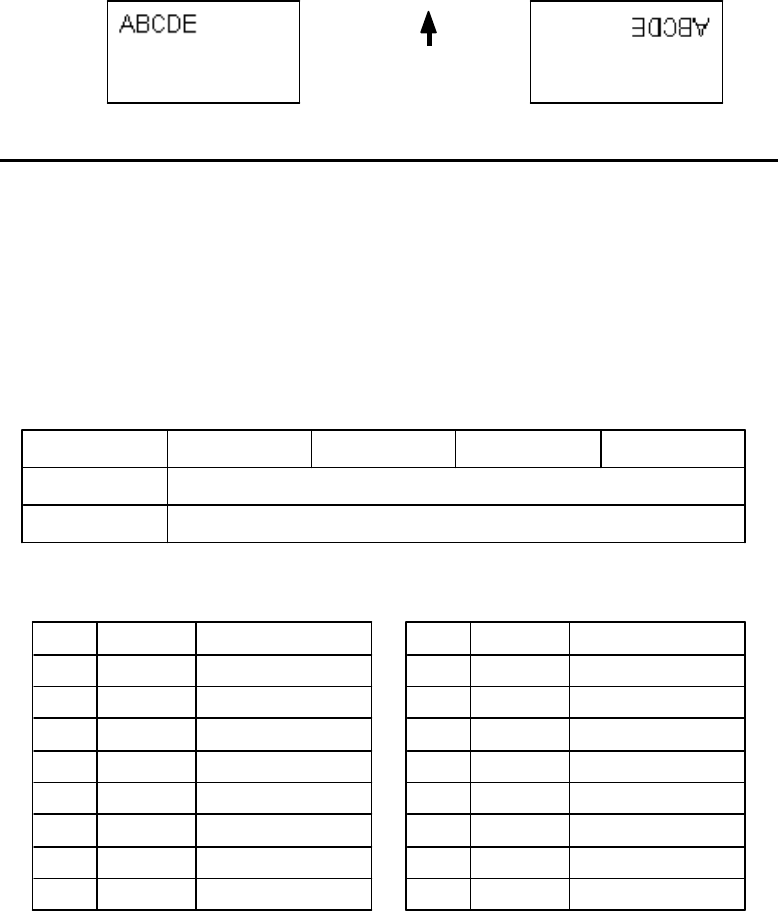
2)This command isenabled onlywhen processed at the beginning
ofaline instandardmode.
3)When this command isinputin page mode, the printerperforms
onlyinternalflag operations.
4)This command doesnotaffectprinting in page mode.
5)In upside-down printing mode, the printer rotatesthe line to be
printed by180 degree and then printsit.
[Default] n=0
[Example]
GS!n
[Name]Selectcharactersize
[Format] ASCII GS!n
HEX 1D21 n
Decimal29 33 n
[Range]0<= n<= 255
[Description](1<=verticalnumberof times<=8,1<=horizontalnumberof times<=8)
Selectsthe characterheightusing bits0to2andselectsthe
characterwidth using bits4to 7,asfollows;
Table 1 Table 2
Characterwidthselection Characterheightselection
BitOff/OnHex DecimalFunction
0-3Characterheightselection.See table 2
4-7Characterwidthselection.See table 1
Hex DecimalHeight
00 0 1(normal)
01 1 2(double height)
02 2 3
03 3 4
04 4 5
05 5 6
06 6 7
07 7 8
Hex DecimalWidth
00 0 1(normal)
10 16 2(doublewidth)
20 32 3
30 48 4
40 64 5
50 80 6
60 96 7
70 112 8
Paperfeed direction

[Notes]1)This command isall characterseffective
2)If nisoutside of the defined range, this command isignored.
3)Instandardmode, the verticaldirection isthe paperfeed direction,
and the horizontaldirection isperpendiculartothe paperfeed
direction.
4)In page mode,verticaland horizontaldirectionsare based on the
characterorientation.
5)When charactersare enlarged with differentsizeson one line,all
the characterson the line are aligned at the baseline.
6)The ESC!command can alsoturn doublewidth and double
heightmodeson oroff.
[Default] n=0
[Reference]ESC!
GS$nL nH
[Name]Turn emphasized mode on/off.
[Format] ASCII GS$ nL nH
HEX 1D45 nL nH
Decimal29 36 nL nH
[Range]0<= nL <= 255,0<= nH<= 255
[Description]Setsthe absoluteverticalprintstarting position forbuffercharacter
datain page mode.
[Notes]1)This command setsthe absolute printposition to[(nL+nHx256)]x
(verticalorhorizontalmotion unit)inches.
2)This command iseffective onlyin page mode.
3)If the [(nL+nHx256)]x(verticalorhorizontalmotion unit)exceeds
the specified printing area, this command isignored.
4)The horizontalstarting bufferposition doesnotmove.
5)The referencestarting position isthatspecified byESCT.
6)This command operatesasfollows,depending on the starting
position of the printing area specified byESCT;
When the starting position is set tothe upperleft orlower right,
this command setsthe absolute position inthe verticaldirection.
When the starting position is set tothe upper rightorlowerleft,
this command setsthe absolute position inthe horizontaldirection.
7)The horizontaland verticalmotion unitarespecified byGS P.
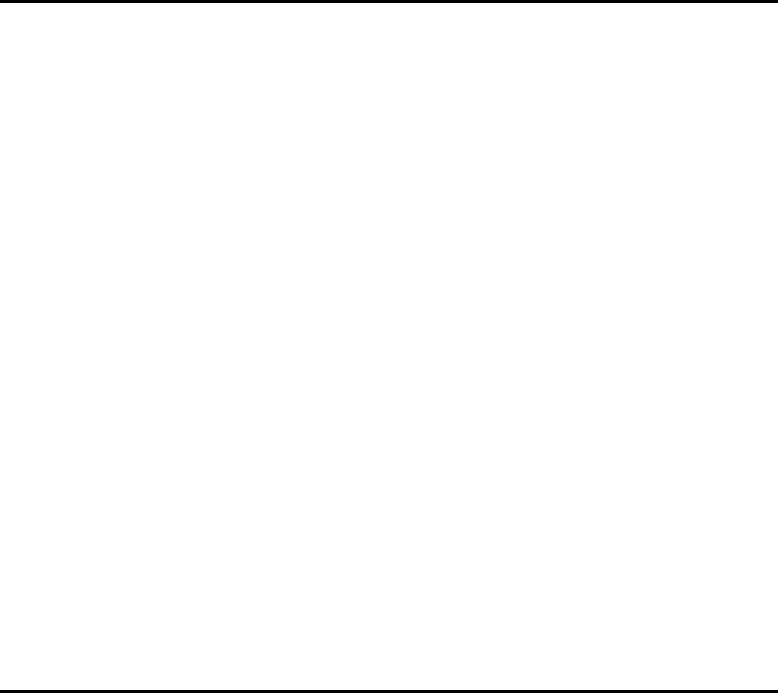
8)The GS P command can change the horizontaland verticalmotion
unit.
However, the value cannotbe less than the minimumhorizontal
movementamount, and itmustbe in even unitsof the minimum
horizontalmovementamount.
[Reference]ESC$,ESCT,ESCW,ESC\, GS P,GS\
GS:
[Name]Start/End macro definition
[Format] ASCII GS:
HEX 1D3A
Decimal29 58
[Description]Startsendsmacro definition.
[Notes]1)Macro definition startswhen this command isreceived during
normaloperation.Macro definition endswhen this command is
received during macro definition.
2)When GS^isreceived during macro definition, the printerends
macro definition and clearsthe definition.
3)Macroisnotdefined when the poweristurned on.
4)The defined contentsof the macro are notcleared byESC@.
Therefore,ESC@can be included inthe contentsof the macro
definition.
5)If the printer receivesGS:againimmediatelyafterpreviously
receiving GS: the printer remainsinthe macro undefined state.
6)The contentsof the macrocan be defined up to 2048 bytes. If
the macro definition exceed 2048 bytes,excess dataisnotstored.
[Reference]GS^
GSBn
[Name]Turnwhite/black reverse printing mode on/off.
[Format] ASCII GS B n
HEX 1D42 n
Decimal29 66 n
[Range]0<= n<= 255
[Description]Turnson oroff white/black reverse printing mode.
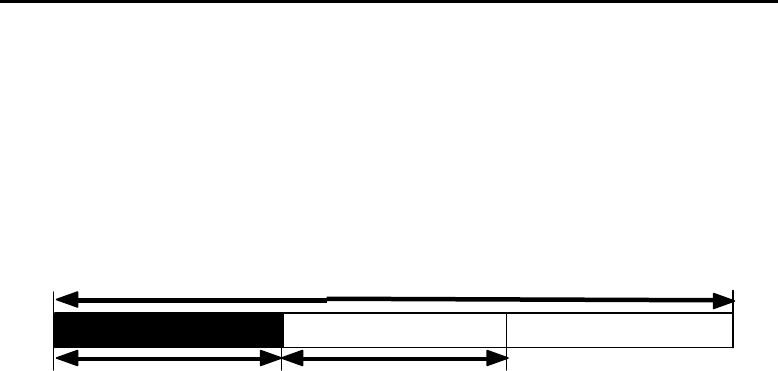
[Notes]1)When the LSB is0,white/black reverse printing mode isturned on.
2)When the LSB is1,white/black reverse printing mode isturned off.
3)Onlythe lowestbitofnis valid.
4)This command isavailableforbuiltincharactersand userdefined
characters.
5)When white/black reverse printing mode ison,italso applied to
characterspacing setbyESCSP.
6)This command doesnotaffect the space between lines.
7)White/black reversemode hasa higherprioritythan underline mode.
Even ifunderline mode ison,itisdisabled (butnotcanceled)
when white/black reversemode is selected.
[Default] n=0
GSL nL nH
[Name]Setleft margin.
[Format] ASCII GSL nL nH
HEX 1D4CnL nH
Decimal29 76 nL nH
[Range]0<= nL <= 255,0<= nL <= 255
[Description]Setsthe left margin using nL and nH.
[Notes]1)The left marginis set to[(nL+nHx256)]x(horizontalmotion unit)
inches.
Printable area
Left marginPrinting area width
2)This command iseffective onlyprocessed at the beginning of the
line instandardmode.
3)If this command isinputin page mode, the printerperformsonly
internalflag operations.
4)This command doesnotaffectprinting in page mode.
5)If the setting exceedsthe printable area, the maximumvalue of
the printable area isused.
6)The horizontaland verticalmotion unitsarespecified byGS P.
Changing the horizontaland verticalmotion unitdoesnotaffect

the currentleft margin.
7)The horizontalmotion unit(x)isused forcalculating the left
margin.The calculated resultistruncated tothe minimumvalue of
the mechanicalpitch.
[Default] nL =0,nH=0
[Reference]GS P,GSW
GSPx y
[Name]Sethorizontaland verticalmotion units.
[Format] ASCII GSPx y
HEX 1D50 x y
Decimal29 80 x y
[Range]0<= x<= 255,0<= y<= 255
[Description]Setsthe horizontaland verticalmotion unitsto approximately25.4/x
mm(1/xinch)and approximately25.4/ymm(1/yinch),respectively.
When xand yareset to 0, the defaultsetting ofeachvalue isused.
[Notes]1)The horizontaldirection isperpendiculartothe paperfeed
direction and the verticaldirection isthe paperfeed direction.
2)Instandardmode, the following commandsusexory,regardless
ofcharacter rotation (upside-down).
Command using x:ESCSP,ESC$,ESC\, GSL,GSW
Command using y:ESC3,ESCJ
3)In page mode, the following command usexory,depending on
characterorientation;
When the printstarting position is set tothe upperleft orlower
rightof the printing area using ESCT(dataisbuffered inthe
direction perpendiculartothe paperfeed direction);
Command using x:ESCSP,ESC$,ESCW,ESC\
Command using y:ESC3,ESCJ,ESCW,GS$,GS\
When the printstarting position is set tothe upper rightorlower
left of the printing area ESCT(dataisbuffered inthe paper
feed direction);
Command using x:ESC3,ESCJ,ESCW,GS$,GS\
Command using y:ESCSP,ESC$,ESCW,ESC\
4)The command doesnotaffect the previously specified values.
5)The calculated result fromcombining this command with othersis
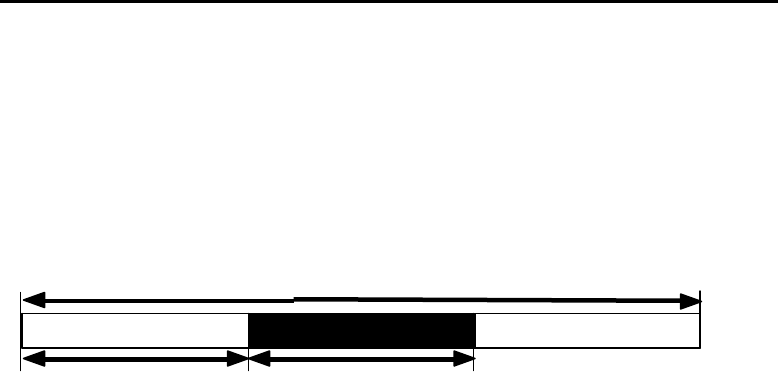
truncated tothe minimumvalue of the mechanicalpitch.
[Default] x=180,y=360
[Reference]ESCSP,ESC$,ESC3,ESCJ,ESCW,ESC\, GS$,GSL,
GSW,GS\
GSWnL nH
[Name]Setprinting area width.
[Format] ASCII GSWnL nH
HEX 1D57 nL nH
Decimal29 87 nL nH
[Range]0<= nL <= 255,0<= nH<= 255
[Description]Setsthe printing area widthtothe area specified bynL and nH.
[Notes]1)The printing area widthis set to[(nL+nHx256)]xhorizontalmotion
unitinches.
Printable area
Left marginPrinting area width
2)This command iseffective onlyprocessed at the beginning of the
line.
3)In page mode, the printerperformsonlyinternalflag operations.
4)This command doesnotaffectprinting in page mode.
5)If the [left margin+printing area width]exceedsthe printable area,
(printable area width-left margin)isused.
6)The horizontaland verticalmotion unitsarespecified byGS P.
Changing the horizontaland verticalmotion unitsdoesnotaffect
the currentleft margin.
7)The horizontalmotion unit(x)isused forcalculating the printing
area width.The calculated resultistruncated tothe minimum
value of the mechanicalpitch.
8)If the widthset forthe printing area isless than the width ofone
character,when the characterdataisdeveloped, the following
processing isperformed;
The printing area widthisextended tothe right to accommodate
one character.
Printable area
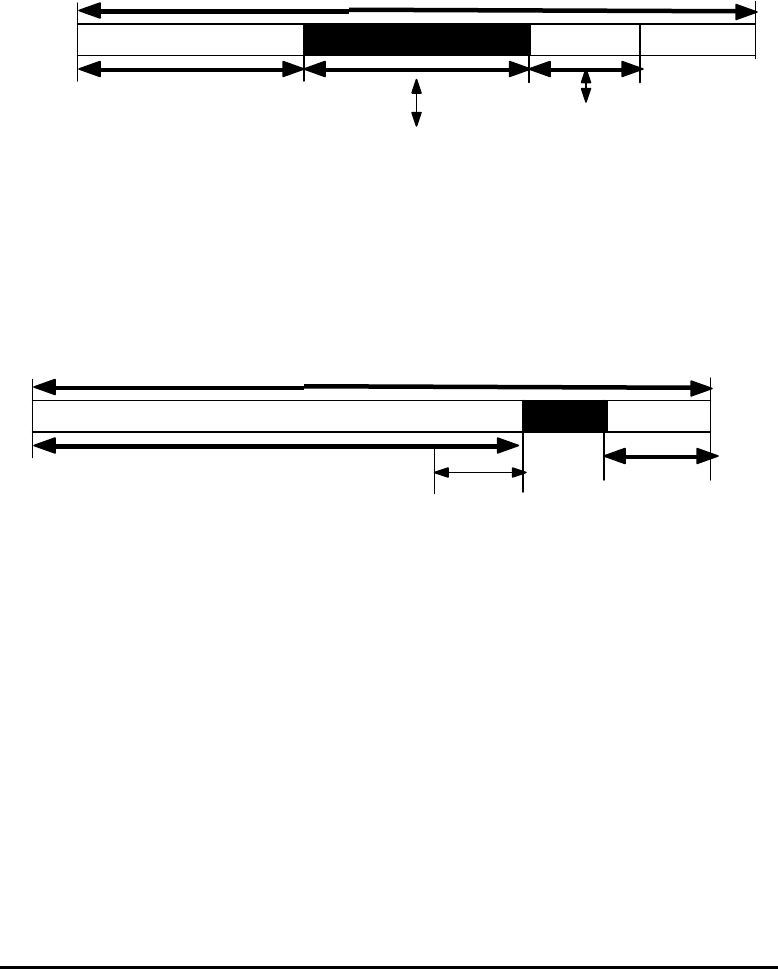
Left marginExtended toright
Printing area widthsetnL and nH
If the printing area widthcannotbe extended sufficiently, the left
marginisreduced to accommodate one character.
Printable area
Left margin
Reduced left marginExtended toright
If the printing area widthcannotbe extended sufficiently, the right
spaceisreduced.
9)If the widthset forthe printing area isless than one line in
vertical, the following processing isperformed onlyon the line in
question when data otherthan characterdata(e.g., bitimage,user
defined bitimage)isdeveloped:
The printing area widthisextended tothe right to accommodate
one line inverticalforthe bitimage withinthe printable area.
If the printing area widthcannotbe extended sufficiently, the left
marginisreduced to accommodate one line invertical.
[Default] nL =0,nH=2
[Reference]GSL,GS P
GS\nL nH
[Name]Setrelativeverticalprintposition in page mode
[Format] ASCII GS\nL nH
HEX 1D5CnL nH
Decimal29 92 nL nH
[Range]0<= nL <= 255,0<= nH<= 255
[Description]Setsthe relativeverticalprintstarting position fromthe current

position in page mode.
[Notes]1)This command setsthe distancefromthe currentposition to[(nL
+nHx256)]x verticalorhorizontalmotion unitinches.
2)This command isignored unless page mode is selected.
3)When pitchNis specified tothe movementdownward;
nL +nHx256 =N
When pitchNis specified tothe movementupward(the negative
direction),usethe complementof65536.
When pitchNis specified tothe movementupward;
nL +nHx256 =65536 -N
4)Any setting thatexceedsthe specified printing area isignored.
5)This command function asfollows,depending on the printstarting
position setbyESCT;
When the starting position is set tothe upperleft orlower rightof
the printing, the verticalmotion unit(y)isused.
When the starting position is set tothe upper rightorlowerleft of
the printing, the horizontalmotion unit(x)isused.
6)The horizontaland verticalmotion unitarespecified byGS P.
7)The GS P command can change the horizontal(and vertical)
motion unit. However, the value cannotbe less than the minimum
horizontalmovementamount, and itmustbe in even unitsof the
minimumhorizontalmovementamount.
[Reference]ESC$,ESCT,ESCW,ESC\, GS$,GS P
GS^rtm
[Name]Executemacro.
[Format] ASCII GS^rtm
HEX 1D5Ertm
Decimal29 94 rtm
[Range]0<= r<= 255
0<= t<= 255
m=0,1
[Description]Executesamacro.
[Notes]1)rspecifiesthe numberof timesto executethe macro.
2)tspecifiesthe waiting timeforexecuting the macro.
3)mspecifiesmacro executing mode.
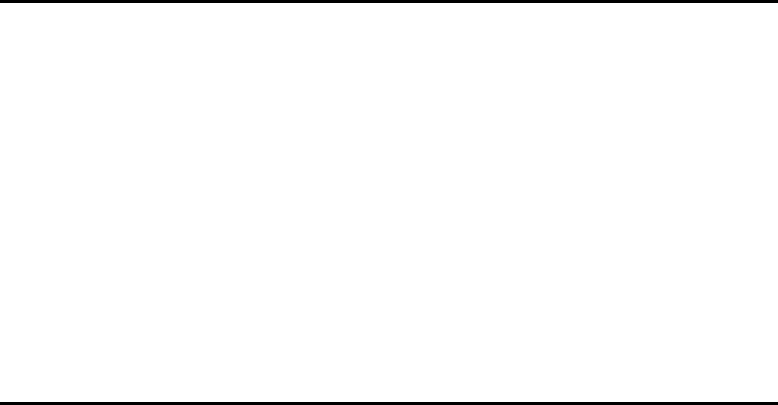
When LSB ofm=0
The macro executesrtimes continuouslyat the intervalspecified
byt.
When LSB ofm=1
Afterwaiting forthe period specified byt, the ERRORLED
indicatorsblinkand the printerwaitsforthe FEEDbutton to be
pressed.Afterthe button ispressed, the printerexecutesthe
macro once.The printer repeatsthe operation rtimes.
4)The waiting timeistx100 msforeverymacro execution.
5)If this command isreceived whileamacroisbeing defined, the
macro definition isaborted and the definition is cleared.
6)If the macroisnotdefined orifis0,nothing isexecuted.
7)When the macroisexecuted (m=1),paperalways cannotbe fed
byusing the FEEDbutton.
[Reference]GS:
GSh n
[Name]Setbarcode height
[Format] ASCII GSh n
HEX 1D68 n
Decimal29 104 n
[Range]1<= n<= 255
[Description]Set the heightof the barcode
nspecifiesthe numberofdotsinthe verticaldirection.
[Default] n=162
[Reference]GSk
GSkmd1...dkNULGSkmn d1...dn
[Name]Printbarcode
[Format] ASCII GSkmd1...dkNUL
HEX 1D6Bmd1...dk00
Decimal29 107 md1...dk0
ASCII GSkmn d1...dn
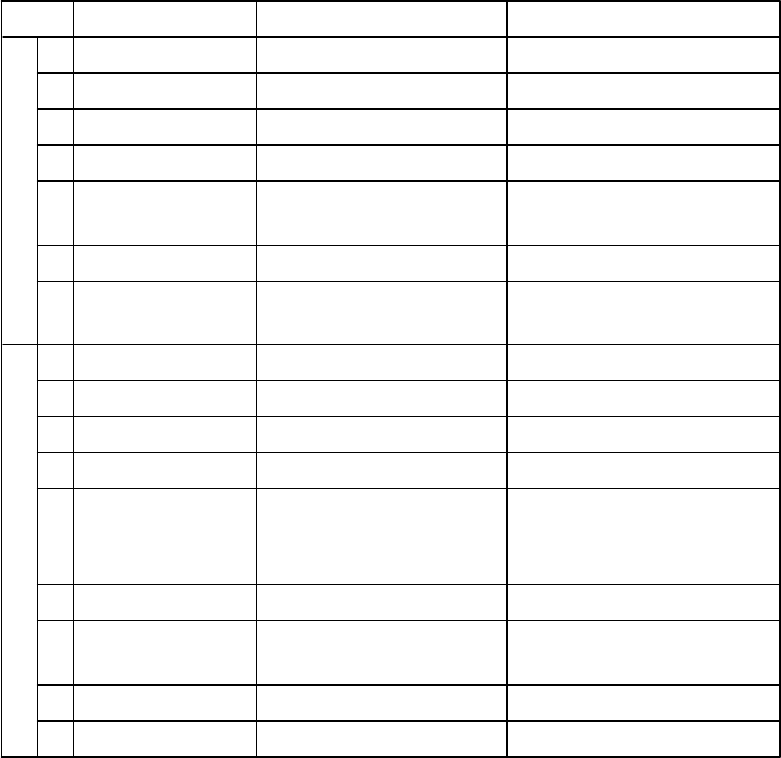
HEX 1D6Bmn d1...dn
Decimal29 107 mn d1...dn
[Range]0<= m<= 6(kand d dependson the barcode systemused.)
65 <= m<= 73 (n and d dependson the barcode systemused.)
[Description]Selectsa barcode systemand printsthe barcode.
mselectsa barcode systemasfollows.
[Notes]1)This command endswithaNULcode.
2)When the barcode systemused isUPC-AorUPC-E, the printer
printsthe barcode data after receiving 12 bytesbarcode data and
processesthe following data asnormaldata.
3)When the barcode systemused inJAN13(EAN13), the printer
mBarcode systemNumberofcharactersRemarks
0UPC-A11<=k<=12 48<=d<=57
1UPC-E11<=k<=12 48<=d<=57
2JAN13(EAN13)12<=k<=13 48<=d<=57
3JAN8(EAN8)7<=k<=8 48<=d<=57
4CODE39 1<=k48<=d<=57,65<=d<=90,32,
36,37,43,45,46,47
5ITF 1<=k(even number) 48<=d<=57
6CODABAR1<=k48<=d<=57,65<=d<=68,
36,43,45,46,47,58
65 UPC-A11<=n<=12 48<=d<=57
66 UPC-E11<=n<=12 48<=d<=57
67 JAN13(EAN13)12<=n<=13 48<=d<=57
68 JAN8(EAN8)7<=n<=8 48<=d<=57
69 CODE39 1<=n<=255
48<=d<=57,65<=d<=90,32,
36,37,43,45,47,47
d1=dk=42(1)
70 ITF 1<=n<=255(even number) 48<=d<=57
71 CODABAR1<=n<=255 48<=d<=57,65<=d<=68,36,4
3,45,46,47,58
72 CODE93 1<=n<=255 0<=d<=127
73 CODE128 2<=n<=255 0<=d<=127
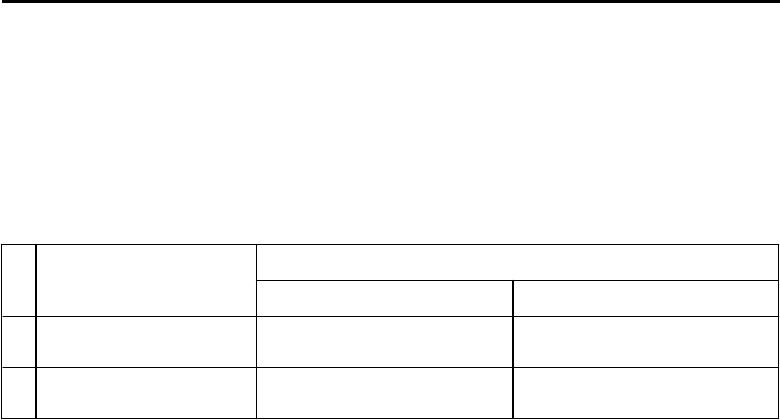
printsthe barcode after receiving 13 bytesbarcode data and
processesthe following data asnormaldata.
4)When the barcode systemused inJAN8(EAN8), the pritnerprints
the barcode after receiving 8 bytesbarcode data and processes
following data asnormaldata.
5)The numberofdataforITF barcode mustbe even numbers.
When an odd numberofdataisinput, the printerignoresthe last
received data.
6)nindicatesthe numberofbarcode data,and the printer
processesn bytesfromthe nextcharacterdata asbarcode data.
7)If nisoutside of the specified range, the printerstops command
processing and processesthe following data asnormaldata.
8)Besuretokeep spaceson bothrightand left sidesofa barcode
Spacesare differentdepending on the typesof the barcode.
[Reference]GSh,GSW,GSw
GSwn
[Name]Setbarcode width
[Format] ASCII GSwn
HEX 1D77 n
Decimal29 119 n
[Range]2<= n<= 3
[Description]Set the horizontalsize of the barcode.
nspecifiesthe barcode width asfollows.
1)Multi levelbarcodesare asfollows
UPC-A,UPC-E,JAN13(EAN13),JAN8(EAN8),CODE93,CODE128
2)Binarylevelbarcodesare asfollows
CODE39, ITF,CODABAR
[Default] n=3
nModulewidthfor
multi levelbarcode
Binarylevelbarcode
Thinelementwidth(mm)Thick elementwidth(mm)
2 0.282 0.282 0.706
3 0.423 0.423 1.129

[Reference]GSk
ESCZmnkd d1...dn
[Name]Print2Dbarcode
[Format] ASCII ESCZmnkd d1...dn
HEX 1B5Amnkd d1...dn
Decimal27 90 mnkd d1...dn
[Range]1<= m<= 7
0<= n<= 8
2<= k<= 5
1<= d<= 65535
[Description]Print2Dbarcode (PDF417 format).
mspecifies column numberof2Dbarcode.
nspecifies securityleveltorestorewhen barcode image isdamaged
kisused fordefine horizontaland verticalratio.
dis consistof2 byte.1stbyteislowernumber.And 2nd byteis
uppernumber.
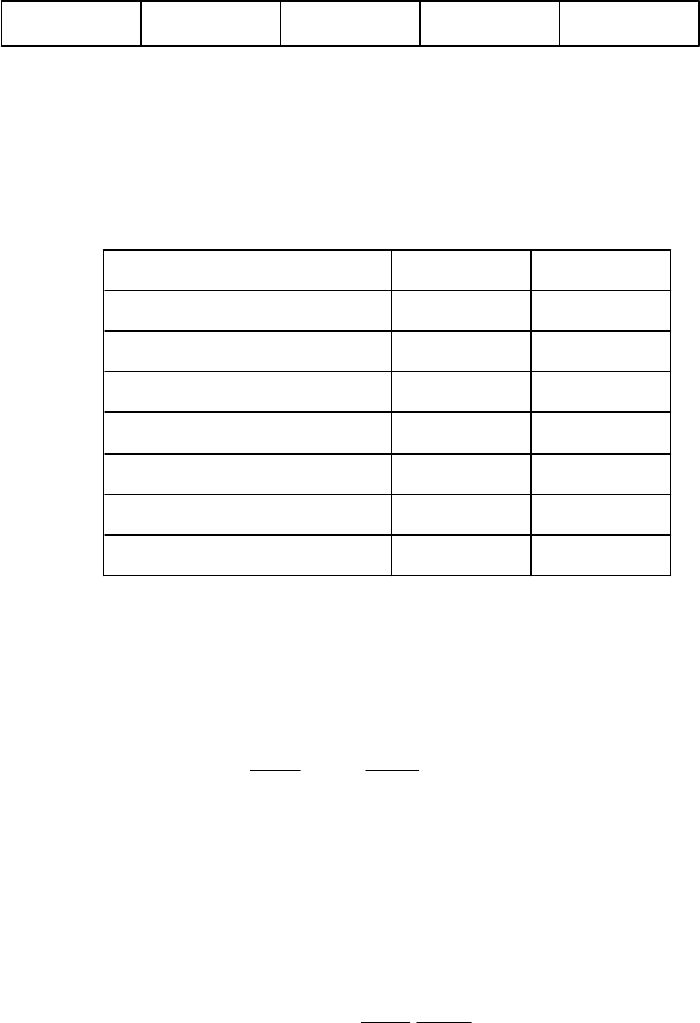
Chapter5. Introduction ofprotocol IrDA
5.1Frame structure
SOF:Startof frame(SOFcode mustbe 0xC0)
TOF:Type of frame(See the tableshown below)
EOF:End of frame(EOFcode mustbe 0xC1)
CHECKSUM:Checksumisnecessaryincase of the TOFcode is0x44.
DATA:Dataisin need of the TOFcode is0x44,0x05,0x53.
TOF:
1. If the code (0xC0,0xC1,0x7D)isincluded on sending data, firstinsert0x7D
code, then operateXOR withthatcode and 0x20.
Example: Incasethe send datais0x20 0x7D0xC1, the sending datawill
be 0x20 0x7D0x5D0x7D0xE1.
Note:The bolded characterisinserted data.
And the underlined chacteristhe data operated XOR with 0x20.
2. If the code 0x7Disincluded on receiving, firstremove 0x7Dcode, then
operateXOR with nextcode and 0x20.
Example: Incasethe received datais0x20 0x7D0x5D0x7D0xE1,
the realdatawill be 0x20 0x7D0xC1.
Note:The underlined chacteristhe data operated XOR with 0x20.
SOF TOFDATACHECKSUMEOF
Type of frameCode Data
ACK0x06 X
NACK0x15 X
ENQ0x05 O
Printdata 0x44 O
Require printerstatus0x53 O
Response printerstatus0x51 X
EOT0x04 X
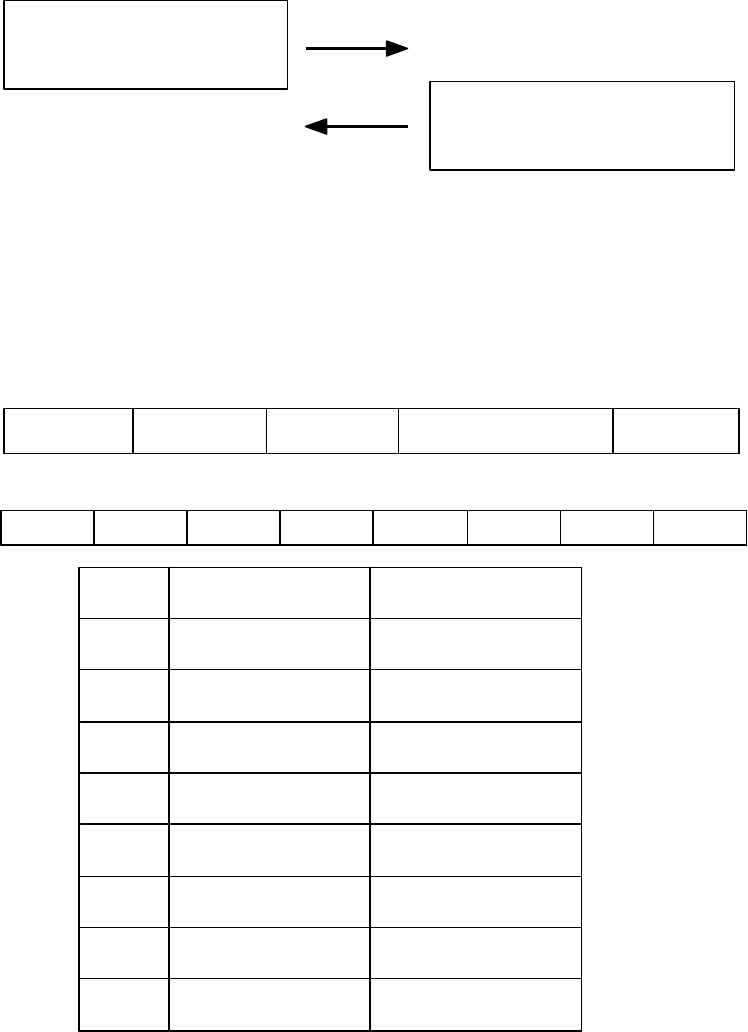
5.2Process ofprinterstatusinquiry
HOSTPRINTER
1. If thereisno responsefromprinter,afterfifthtimesrecheck with every400ms,
then displaythe errormessage such as"The printercannot fined"on your
displaypanelsamelikeCRT,PDA,etc.
2.Structure ofprinterstatusresponseframe
-STATUS
SOF0x53 STATUS PreviousDATAIDEOF
Bit7Bit6Bit5Bit4Bit3Bit2Bit1Bit0
BitONOFF
0PaperemptyNormal
1 LowbatteryNormal
2Head open Normal
3Notdefined Notdefined
4Notdefined Notdefined
5Notdefined Notdefined
6Notdefined Notdefined
7Notdefined Notdefined
Printerstatus
requireframetransmit
Printerstatus
responseframetransmit
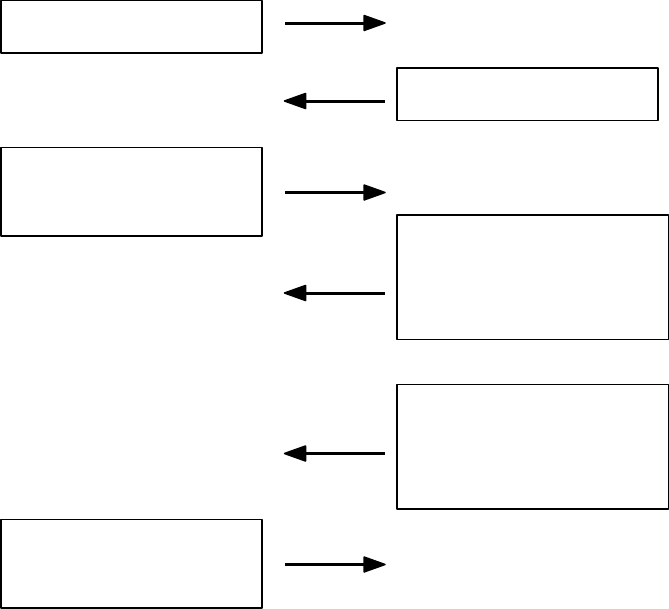
-PreviousDATAID:Finallyused DATAID
5.3Process of transmitting and receiving printdata
HOSTPRINTER
1. It iserrorcondition shown below.
-Wrong checksumreceived
-No datareceived within 200msafterdatareceive.
-Thereisno 0xC1code afterchecksum
-It isnotnumbercode (0x30 -0x39)in datalengthfield.
ENQ frametransmit
ACKframetransmit
Printdataframe
transmit
If thereisno error
during datatransmit,
EOTframetransmit
If thereisanyerror
during datatransmit,
NACKframetransmit
Printdataframe
transmitagain

5.4Structureofprintdataframe
1.DATAID:Itismade up 1 digitnumber.
The range is0-9.
The numbermustbe charactercode.
2.DATALength:Itconsistsof4 digitnumbers.
The range is0001 -9999.
The numbermustbe charactercode.
Example-If you want tosend 4 numbersdatato printer,
you mustsend 0x30 0x30 0x30 0x34 codesasdatalength.
3.CHECKSUM:Itis composed of2 bytes.
1stbyteisoperated XORvalue with odd numbersofdata.
And 2nd byteisoperated XORvalue with even numbersofdata
Example-Incase ofprintdataisSAMPLETEST,datalengthis0011
(0x30 0x30 0x31 0x31), the 1stbyte ofchecksumisoperated XOR
value withS,M,L,space,E,T,and 2nd bytechecksumisopera-
ted XORvalue withA,P,E,T,S.
Note:
1.Do nothave timeintervalover200mson transmitting printdata.
2. Ifnotreceive EOT orNACK framewithin1 second aftertransmitting
printdata completely, jumptothetransmitting ENQframe.
3. Ifreceive EOTframe afterprintdatatransmitted,quit theprintoperation
4. Incase ofreceiving NACK frame, ifreceive NACK framemorethanthree
times aftertransmitprintdatathree times,display CHECK PRINTER
STATUSon yourdisplay paneland waitoperator'smeasures.
SOF0x44 DATAIDDATA
Length
Print
DATACHECKSUMEOF

5.5StructureofENQframe
1. If thereisno responseACKframe aftertransmitting ENQframefromhost,
transmitagainENQframe afterwaiting 400ms.
2. Incase ofno response over10 timesfromprinteraboutENQframe,display
PRINTER CANNOT FINDEDmessage on the yourdisplaypanel,and wait
operator'smeasures.
SOF0x05 DATAIDEOF
APPENDIX
A.MISCELLANEOUSNOTES
1.Printermechanismhanding
1)Do notpull the paperoutwhen the coveris closed.
2)Becausethe thermalelementsof the printhead and driverICsare easy to
break,so do not touchthemwith anymetalobjects.
3)Sincethe areasaround the printhead becomeveryhotduring and justafter
printing,do not touchthem.
4)Do notusethe coveropen button exceptwhen necessary.
5)Do not touchthe surface of the printhead because bustand dirtcan stick
tothe surface and damage the elements.
6)Thermalpapercontaining Na,K,Cl ions can harmthe printhead thermal
elements.
Therefore,be sureto use onlythe specified paper.
7)If you want to uselabelpaper,pleasecontactyourdealerforassistance.
2.Thermalpaperhandling
Noteson using thermalpaper
Chemicalsand oil on thermalpapermay cause discoloration and faded printing.
Therefore,payattention tothe following;
1)Usewaterpaste,starch paste,polyvinylpaste,orCMCpastewhen gluing
thermalpaper.
2)Volatile organic solvents such asalcohol,ester,and ketone can cause
discoloration.
3)Some adhesivetapesmay cause discoloration orfaded printing.
4)If thermalpapertouchesanything whichincludesphthalicacid esterplasticizer
foralong time,itcan reducethe image formation abilityof the paperand
can causethe printed image tofade.Therefore,when storing thermalpaperin
acardcase orsample notebook,be sureto use onlyproductsmade from
polyethylene,polypropylene,orpolyester.
5)If thermalpapertouchesdiazocopypaperimmediatelyaftercopying, the
printed surfacemaybe discolored.
6)Thermalpapermustnotbe stored withthe printed surfacesagainsteach
otherbecausethe printing maybe transferred between the surfaces.
7)If the surface of thermalpaperis scratched with a hardmetalobjectsuch as
a nail, the papermaybecome discolored.
Noteson thermalpaperstorage
Sincecolordevelopmentbeginsat70C(158F), thermalpapershould be
protected fromhigh temperature,humidity,and light, both before and after
printing.
1)Store paperawayfromhigh temperature and humidity.
Do notstorethermalpaperneara heaterorin enclosed placesexposed to
directsunlight.
2)Avoid directlight
Extended exposureto directlightmay cause discoloration orfaded printing.
3.Others
Becausethisprinterusesplated steel, the manualcutting edge maybe
subject torust.
However, thisdoesnotaffect the printerperformance.
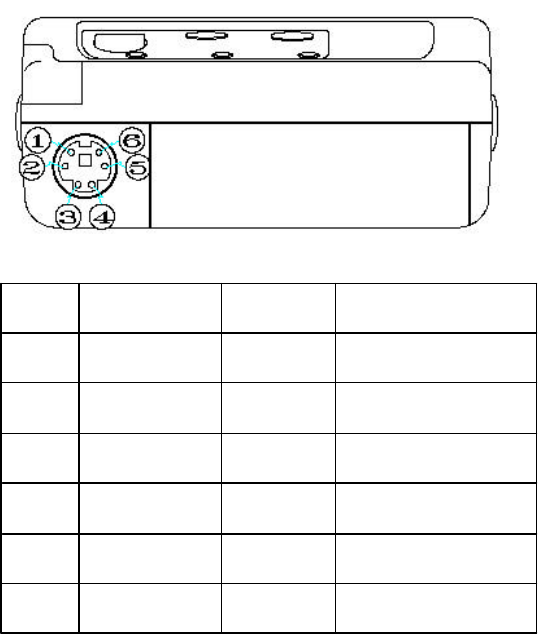
B.CONNECTORS
Pin no SignalnameDirection Function
1TxDOutputTransmitData
2NC - -
3RxDInputReceiveData
4CTSOutputCleartosend
5RTSInputRequest tosend
6GND InputGround
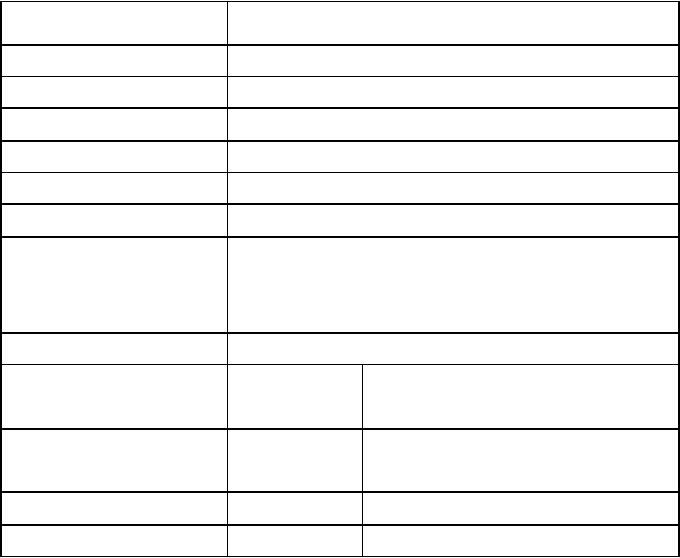
C.Specification
Printing method Direct thermal line printing
Dotdensity203 DPI
Printing width48 mm
Paperwidth57 -58 mm
Charactersperline40
Printing speed50mm /sec
Receive buffersize10Kbytes
Note
Printing speed maybe slower,depending on
the datatransmission speed and the
combination ofcontrolcommands.
Supply voltage7.2DCV/1.8A
Environment
conditionsTemperature0C-40C(operating)
-10C-50 (storage)
Humidity30%-80%(operating)
10%-90%(storage)
MCBFMechanical37,000,000 lines
Head Approximately100 Km